Goodbye, Gillnets
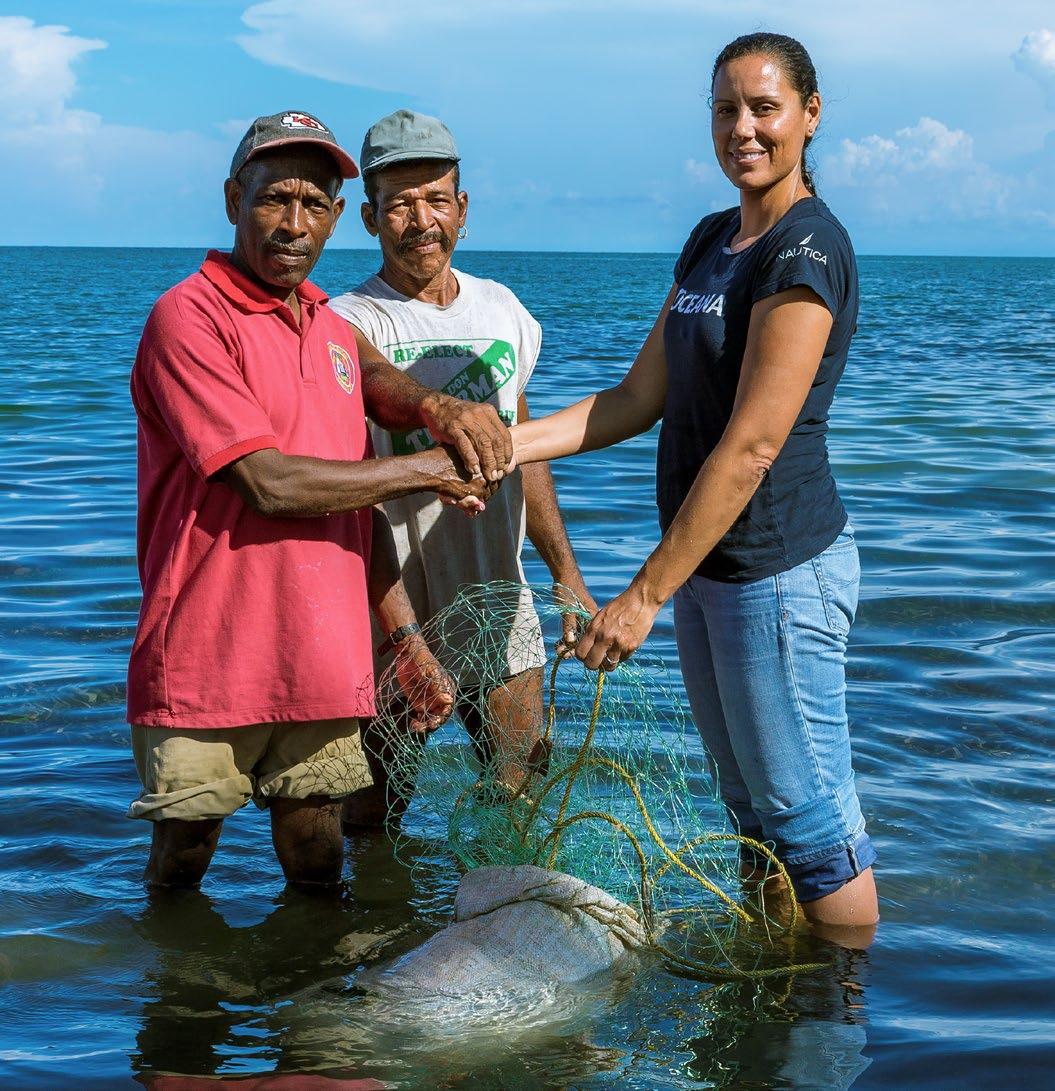
Opting Out Amazon packages are awash in plastic, and shoppers want alternatives
Q&A with Sam Waterston
WINTER 2020 OCEANA.ORG
Belize bans deadly fishing gear, protecting countless marine animals
Magazine
On cod, climate change, and his latest role: Oceana Board Chair
© Oceana/Alex Ellis
Ray Jacobs (left) hands over his gillnet to Janelle Chanona, Oceana’s Vice President in Belize. Also pictured is Fidel Audinett (center), a Belizean fisher who had been petitioning the government to ban gillnets since 1997.
Board of Directors
Sam Waterston, Chair
María Eugenia Girón, Vice Chair
Diana Thomson, Treasurer
James Sandler, Secretary
Keith Addis, President
Gaz Alazraki
Monique Bär
Herbert M. Bedolfe, III
Ted Danson
Nicholas Davis
Sydney Davis
César Gaviria
Loic Gouzer
Jena King
Ben Koerner
Sara Lowell
Stephen P. McAllister
Kristian Parker, Ph.D.
Daniel Pauly, Ph.D.
David Rockefeller, Jr.
Susan Rockefeller
Simon Sidamon-Eristoff
Rashid Sumaila, Ph.D.
Valarie Van Cleave Jean Weiss
Editorial Staff
Editor
Emily Petsko
Designer
Alan Po
Ocean Council
Susan Rockefeller, Founder Kelly Hallman, Vice Chair
Dede McMahon, Vice Chair Anonymous
Samantha Bass
Violaine and John Bernbach Rick Burnes
Vin Cipolla
Barbara Cohn
Ann Colley Edward Dolman
Kay and Frank Fernandez Carolyn and Chris Groobey J. Stephen and Angela Kilcullen
Ann Luskey
Mia M. Thompson
Peter Neumeier Carl and Janet Nolet
Ellie Phipps Price
Maria Jose Peréz Simón
David Rockefeller, Jr. Elias Sacal
Regina K. and John Scully Sutton Stracke
Dr. David Treadway
Edgar and Sue Wachenheim III Valaree Wahler
David Max Williamson Raoul Witteveen Leslie Zemeckis
Oceana Staff
Andrew Sharpless Chief Executive Officer
Jim Simon President
Jacqueline Savitz Chief Policy Officer, North America
Katie Matthews, Ph.D. Chief Scientist
Matthew Littlejohn Senior Vice President, Strategic Initiatives
Janelle Chanona Vice President, Belize
Ademilson Zamboni, Ph.D. Vice President, Brazil
Joshua Laughren
Executive Director, Oceana Canada
Liesbeth van der Meer Vice President, Chile
Pascale Moehrle
Executive Director and Vice President, Europe
Renata Terrazas Vice President, Mexico
Patricia Majluf, Ph.D. Vice President, Peru
Gloria Estenzo Ramos, J.D. Vice President, Philippines
Susan Murray Deputy Vice President, U.S. Pacific
Beth Lowell Deputy Vice President, U.S. Campaigns
Nancy Golden Vice President, Global Development
Christopher Sharkey Chief Financial Officer
Kathy Whelpley
Chief of Staff, President’s Office
Michael Hirshfield, Ph.D. Senior Advisor
Oceana Magazine is published by Oceana Inc. For questions or comments about this publication, or to subscribe to Oceana Magazine, please call our membership department at +1.202.833.3900, email membership@oceana.org, or write Oceana, Member Services, 1025 Connecticut Ave. NW, Suite 200, Washington, DC 20036 USA.
Oceana’s Privacy Policy: Your right to privacy is important to Oceana, and we are committed to maintaining your trust. Personal information (such as name, address, phone number, email) includes data that you may have provided to us when making a donation or taking action as a Wavemaker on behalf of the oceans. This personal information is stored in a secure location. For our full privacy policy, please visit Oceana.org/privacy-policy.
Please Recycle.
FSC Logo
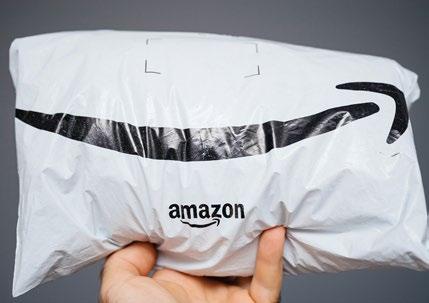
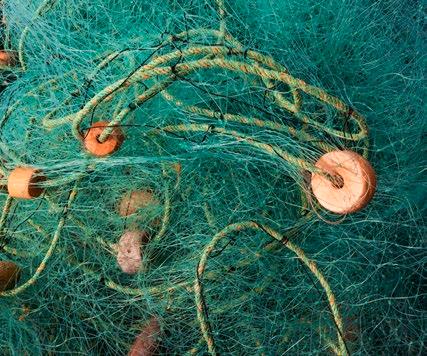
Features Contents To help navigate Oceana’s work, look for these five icons representing our major campaigns. Curb Pollution Stop Overfishing Reduce Bycatch CEO Note Thanks to your support, Oceana presses on in its mission, despite COVID-related challenges For the Win Offshore drilling barred in several U.S. states, single-use plastic banned in Belize, and more News & Notes Global Fishing Watch uncovers illegal fishing, Canadians reject single-use plastics, and more Q&A Sam Waterston on getting arrested with Jane Fonda and his new role at Oceana Opting Out Oceana urges Amazon to give customers a plastic-free packaging option Belize Bans a Triple Threat Trawling was the first to go, then offshore drilling, and now gillnets Oceana’s Victories Looking back at our big wins over the last year Supporter Spotlight BMW is driving positive change in the oceans by supporting Oceana’s SeaChange events Ask Dr. Pauly How do gillnets work? Events SeaChange 2020 and Oceana’s Global Forum Chef’s Corner Mark Bittman’s recipe for baked clams, with a twist Parting Shot A glimpse into a fish landing site in Dangriga, Belize 3 | 4 | 6 | 10 | 8 | 16 | Protect Habitat Increase Transparency 24 | 25 | 26 | 28 | 30 | 32 | A look at Amazon’s plastic footprint 10 Belize bids goodbye to gillnets 16 © Shutterstock/Hadrian © A. Ellis 1
Your support makes an ocean of difference
Please Give Generously Today
A healthy, fully restored ocean could sustainably feed more than 1 billion people each day.
Call us today at (202) 833-3900, email us at info@oceana.org, visit www.oceana.org/give, or use the envelope provided in this magazine to make a donation. Oceana is a tax-exempt 501(c)3 organization and contributions are taxdeductible to the fullest extent of the law.

© Shutterstock/SamanWeeratunga
Dear friend:
All of Oceana’s campaign teams around the world are working from home, as COVID-19 continues to ravage all the countries in which our teams are fighting for the policies that rebuild and restore abundant oceans.
The very good news is that we’ve been able to win – even during the pandemic lockdown – new laws and regulatory actions that save the ocean to help feed the world. You will enjoy reading about these advances in this issue of our magazine.
Financial planning at Oceana has been difficult as our donors wrestle
with uncertainty about the course of the pandemic and related economic collapse. From the ocean’s point of view, conservation protections remain as urgent as ever.
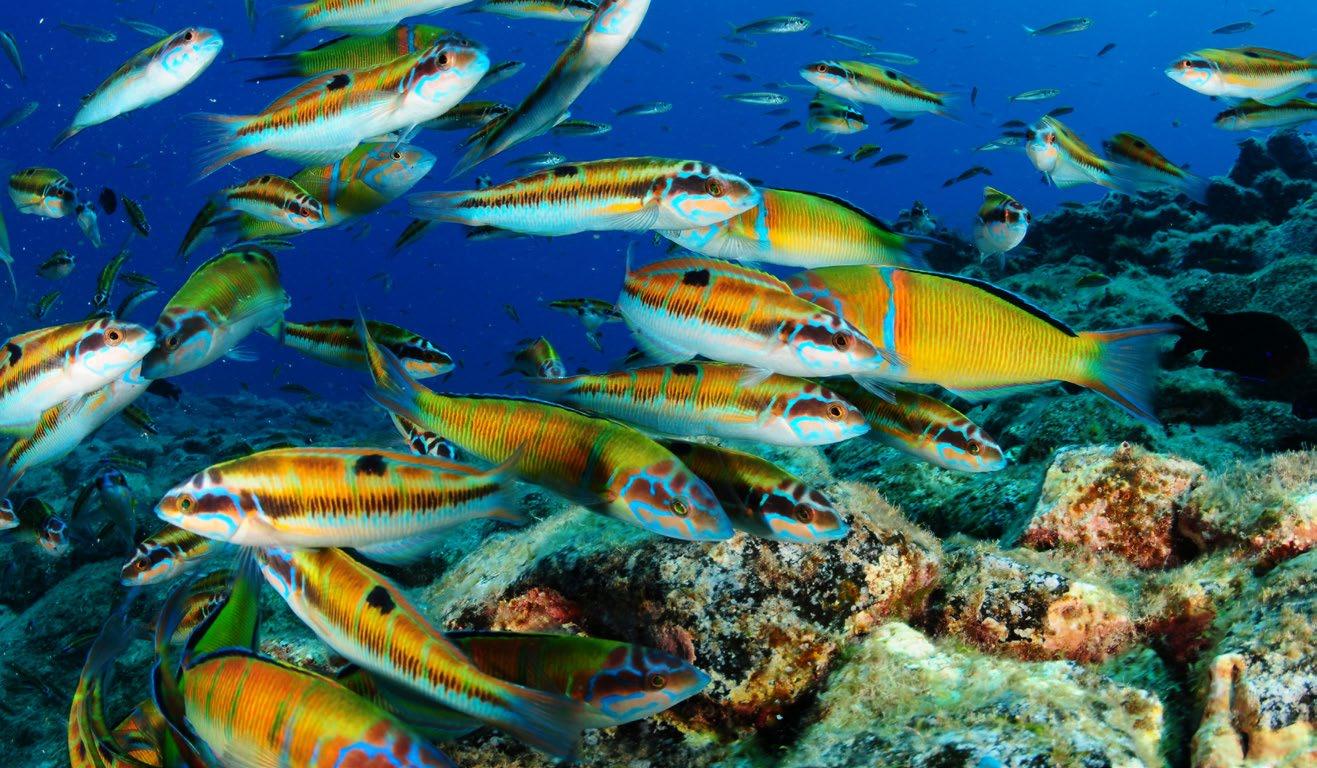

So, when our Board of Directors met this year, via teleconference of course, they decided that Oceana would do everything we can to keep our campaign teams together and to avoid COVID-driven staff furloughs or layoffs.
We have done so. That means we will be ready, as soon as it is safe to do so, to immediately get back to normal campaign operations and to do so at full speed.

Honoring deadlines for achieving our policy objectives is at the core of Oceana’s business-like campaign method. We are challenging ourselves to do so throughout this pandemic.
If you are reading this magazine, you are very likely a donor to Oceana, and your generosity to us through this difficult period is the reason we are
confident about continuing to win in 2021. Thank you! We know that you receive many requests for help.
Your loyalty to Oceana is the reason we told our worldwide campaign staff that their jobs are secure from COVID cuts during 2020, and now also during 2021. Please accept an enthusiastic international chorus of gratitude from all of us.
I hope you are safe. The coming arrival of cold weather in the Northern Hemisphere will test our discipline and our patience. I hope that with the arrival of next summer we will be out of the worst of the pandemic, and again fully immersed in the salty joys of conserving our planet’s astounding ocean.
WINTER 2020 | Oceana.org3
All the best, Andrew Sharpless CEO Oceana
CEO Note
© Oceana/Carlos Minguell
For the Win
Oceana makes strides in U.S. campaign to prevent expansion of offshore oil drilling
Virginia Governor Ralph Northam signed legislation last summer that will ban oil and gas drilling and related infrastructure in state waters. With this law, Virginia joins the growing number of states that have adopted measures to block new offshore drilling, including California, Delaware, Florida, Maine, Maryland, New Hampshire, New Jersey, New York, Oregon, and South Carolina. While states may not have the authority to prevent drilling in federal waters, a ban on infrastructure in state waters is a strong deterrent to companies wishing to drill off a state’s coast.
Around the same time, the U.S. House of Representatives passed legislation that, if enacted, would prohibit the expansion of offshore oil drilling
activities in federal waters for fiscal year 2021 while also blocking new permits for seismic airgun blasting, which harms whales. Separately, a status conference on seismic litigation revealed that the industry will not conduct seismic airgun blasting in the Atlantic this year, and possibly for several years.
Most recently, President Donald Trump announced temporary protections from new offshore oil drilling for Florida, Georgia, South Carolina, and North Carolina in September. The protections will take effect on July 1, 2022 and last for a period of 10 years. While this is an important step, the President has not formally rescinded his oil and gas leasing plan which proposed the expansion of drilling in almost all U.S. ocean waters. Until all coasts are permanently protected, Oceana will continue to campaign for legislation to prevent the expansion of offshore drilling.
U.S. federal judge sides with Oceana, rules that northern anchovy must be better protected
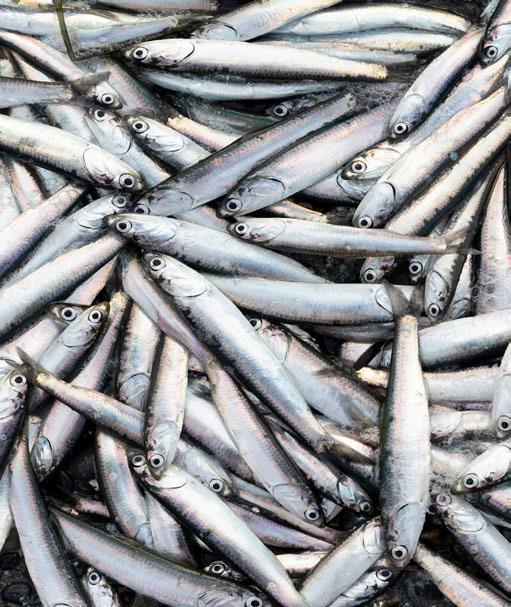
National Oceanic and Atmospheric Administration (NOAA) Fisheries must set a new catch limit for northern anchovy that better protects the important forage fish from overfishing, a federal judge ruled in September. The court sided with Oceana and Earthjustice, whose lawsuit argued that NOAA Fisheries’ rigid annual catch limit of 23,573 metric tons did not account for natural fluctuations within the population. This inflexible approach has created ripple effects for a number of species that feed on anchovy. From 2009-2015, scientists documented an anchovy population collapse as thousands of sea lions starved to death on U.S. West Coast beaches and brown pelicans abandoned their chicks due to an inability to feed them.
“The science is clear – managing a boom and bust fish population with an unchanging catch limit will worsen natural collapses and harm wildlife that depends on anchovy as a food source,” said Dr. Geoff Shester, Oceana’s campaign director in California. “With stateof-the-art acoustic surveys – conducted by NOAA Fisheries’ own scientists – we can manage this critical forage fish more responsibly.”
4
Without the responsive management of northern anchovy populations, whales, sea lions, pelicans, and other animals risk malnourishment. This inhibits their ability to successfully reproduce and raise their babies.
© Shutterstock/Feng Yu
Brazil replaces outdated fishing logbooks with modernized online system
The Brazilian government formally launched online logbooks for its fisheries catch data, bringing citizens, scientists, and decisionmakers one step closer to being able to access this crucial information. This action follows campaigning by Oceana, which in 2018 launched Brazil’s first online logbook for mullet, known locally as tainha. The government used Oceana’s online “tainhometer” as a model for its new system, which replaces outdated, inaccessible paper logbooks that were, in some cases, tucked away in dark rooms and literally forgotten. Previously, Brazil went nearly a decade without publishing fisheries statistics, making it one of the only top 50 fishing nations that did not provide fish catch data to the Food and Agriculture Organization of the United Nations (FAO). With these changes, the Brazilian government can now compile and submit data to FAO and other governmental groups. Oceana continues to advocate for this information to be made more readily available to the public.
Belize
writes
single-use plastic ban into law
After years of campaigning by Oceana and allies, the Belizean government signed a law that will phase out and ultimately ban a number of single-use plastic products, including drinking straws, clamshell containers, throwaway utensils, plastic shopping bags, and Styrofoam foodware. These items represent 20% of the solid waste collected in Belize, and once the ban is fully enacted by the end of 2021, the country’s barrier reef and marine life will be better protected. Oceana continues to push the government to set acceptable standards for alternatives to singleuse plastics, while also supporting businesses that have been early adopters of single-use plastic-free products and practices. According to local media, some businesses have begun offering bamboo straws and refillable glasses.
Brazilian fishers report higher landings of shrimp and other fish in Rio Grande do Sul following bottom trawling ban
Two years after a bottom trawling ban was successfully implemented in the Brazilian state of Rio Grande do Sul, fishers have reported seeing an uptick in shrimp and other species. Artisanal fisher Daniel Guglieri said he has been catching more shrimp as well as other fish that he hadn’t caught in years. “Today we caught a large amount of shrimp – over 1,000 kilos [about 2,200 pounds] on Cidreira Beach,” Guglieri told Oceana.
Likewise, fisher Daniel da Veiga Oliveira from Quintão Beach said, “I don’t ever remember catching as much shrimp as we are catching now. And it’s not just me catching it here on the beach. Just last night, more than 2,000 kilos of shrimp [about 4,400 pounds] were caught here.” Scientists have not yet assessed potential links between the return of certain species and the state’s bottom trawling ban, which was written by local artisanal fishers with support from Oceana. Nevertheless, these reports from fishers provide encouraging anecdotal evidence that the elimination of destructive fishing methods might be delivering results.
fisher Daniel da Veiga Oliveira is pictured in front of crates of acoupa weakfish and whitemouth croaker, two species of commercially important fish in Southern Brazil. He said he has also seen a return in kingfish.
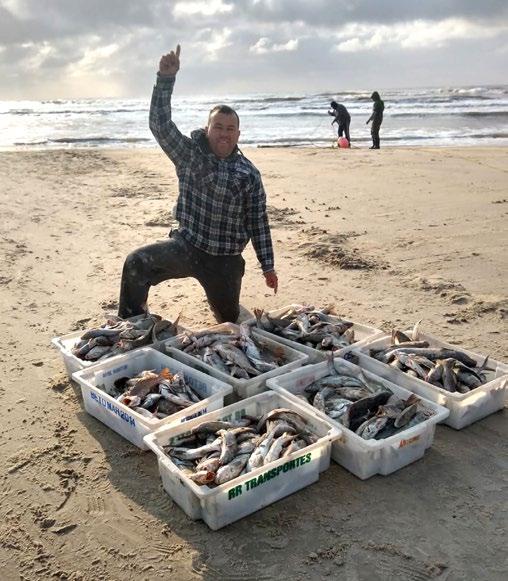
WINTER 2020 | Oceana.org5 5 WINTER 2020 | Oceana.org
Artisanal
© Daniel da Veiga Oliveira
News + Notes
Global Fishing Watch and Oceana reveal illegal and harmful fishing by Chinese fleets
Hundreds of Chinese vessels fished illegally in North Korean waters in 2017 and 2018, according to a recent study authored by international research organizations and Global Fishing Watch, an independent nonprofit founded by Oceana in partnership with Google and SkyTruth. “Dark fleets” like these, which do not broadcast their location or appear in public monitoring systems, can overexploit fish stocks and displace local fishers.
Many North Korean fishers have been traveling further from their home ports in search of fish, undertaking dangerous trips across
rough seas that too often turn deadly. Nearly 600 North Korean “ghost ships” – some carrying fishers’ corpses – have washed ashore in Japan over the last five years. Meanwhile, fishing villages along North Korea’s eastern coast have been called “widows’ villages” because of all the fishermen lost at sea.
A separate analysis by Oceana revealed that nearly 300 Chinese vessels had pillaged waters near the Galápagos Islands – a UNESCO World Heritage Site and biosphere reserve – over the course of one month in 2020. The fleets were primarily fishing for squid, an important food source for the endangered Galápagos fur seal and scalloped hammerhead shark, as well as locally important
commercial species like tuna and billfish. Using the Global Fishing Watch mapping tool, Oceana discovered that Chinese-flagged vessels were responsible for 99% of the visible fishing activity near the country’s exclusive economic zone (EEZ) during this period.
Unfortunately, these two cases of illegal and harmful fishing, respectively, are “just the tip of the iceberg when it comes to the impact of China’s huge distant-water fishing fleet on our oceans,” said Oceana Illegal Fishing and Transparency Analyst Dr. Marla Valentine. Oceana calls on countries to make their vessel tracking data publicly available on Global Fishing Watch’s platform in an effort to increase transparency at sea and curb illegal fishing.

6
The shaded areas at the borders of the Galápagos Islands’ EEZ show where Chinese fishing vessels were detected, with yellow representing the highest number of apparent fishing hours.
Oceana urges stronger protections for endangered North Atlantic right whales in the U.S. and Canada
Speed kills… North Atlantic right whales. Unfortunately, voluntary speed restrictions are not doing enough to protect the few remaining North Atlantic right whales from being struck and possibly killed by large vessels, Oceana found after analyzing ship speeds in U.S. and Canadian waters. Enforcing speed limits of 10 knots in areas where the whales appear – thereby giving a ship more time to maneuver around a whale – can reduce the chances of a whale being killed by a vessel by 86%.
From January 22 to March 6, about 41% of the ships passing through an area south of Nantucket, Massachusetts, exceeded the voluntary speed limit of 10 knots –and some vessels were going more than twice as fast. Similarly, Oceana Canada discovered that 67% of vessels did not obey the 10-knot voluntary speed limit in the Cabot Strait from April 28 to June 15. Given the evidence that voluntary “slowdown zones” are not being observed, Oceana is now urging authorities to adopt mandatory speed restrictions to help protect the estimated 360 remaining North Atlantic right whales. Oceana also launched Ship Speed Watch, a new online tool that lets the public monitor ship speeds through slow zones in the U.S. and Canada in near real-time.
In addition, Oceana is campaigning to reduce the amount of rope used in fixed gear fisheries, which would help North Atlantic right whales avoid deadly entanglement. In August, a federal judge ruled that the U.S. government must take action to protect these whales from the American lobster fishery by May 2021.
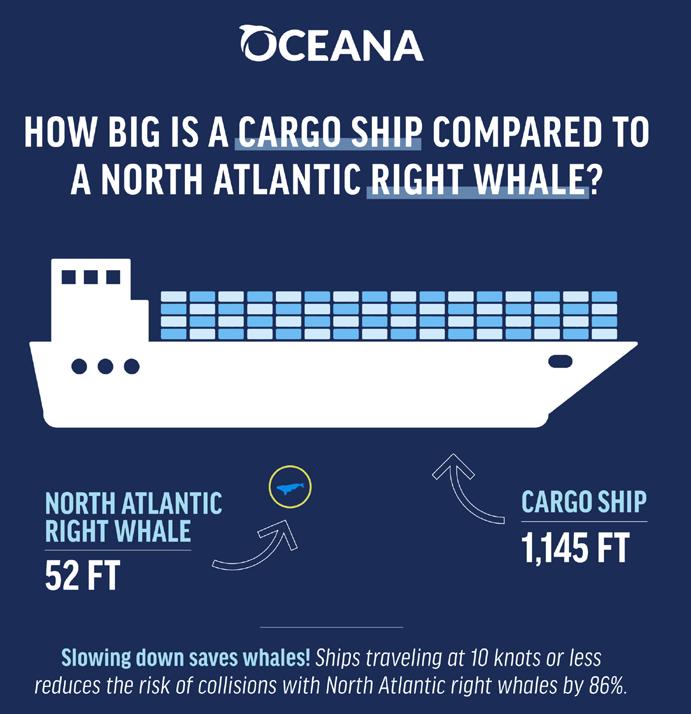
Slowing down to 10 knots can save right whales’ lives. Ten knots is equal to about 11.5 miles per hour, or 18.5 kilometers per hour. Right whales swim at about 6 miles per hour, or 9.7 kilometers per hour.
Canadians overwhelmingly want a national ban on single-use plastics, study finds
The majority of Canadians – 86% – support the government’s commitment to implement a national ban on single-use plastics by 2021, according to an Abacus Data study commissioned by Oceana Canada. This represents a 5% increase from 2019, when a similar survey gauged public opinion on a potential ban. “This research shows that more than ever, Canadians want a future without harmful single-use plastics,” said Kim Elmslie, campaign director for Oceana Canada. “Unequivocally, we want the Canadian government
to take swift and effective action to end the growing plastic disaster.”
On World Oceans Day, Oceana Canada launched a petition calling on government officials to fulfill their commitment to ban unnecessary single-use plastics by 2021. It has garnered more than 100,000 signatures, and it appears to have paid off. Recently, the Minister of Environment and Climate Change Canada said the government intends to ban six types of single-use plastics by the end of 2021. This will include plastic shopping bags, beverage stir sticks, six-pack rings, cutlery, straws, and other foodware made from problematic plastics.
WINTER 2020 | Oceana.org7
Award-winning actor and longtime Oceana supporter Sam Waterston assumed his new leadership role as Board Chair in September, succeeding Valarie Van Cleave. As an advocate and spokesman for Oceana’s campaigns, he has testified before national legislatures on the prevention of shark finning and expansion of offshore drilling. Hailing from the “Bay State” of Massachusetts, Waterston learned early on why marine resources must be protected for future generations to enjoy. “I’ve seen firsthand the damage fisheries mismanagement has done to the life of seaside towns and the healing power of Oceana’s science-based, results-oriented campaigns for an abundant ocean,” he said. “And I’ve seen the impact of unbridled plastic production and pollution, and the North Atlantic on the brink of losing all its right whales forever. With much to do, and time of the essence, I know Oceana gets things done for our oceans. It always has. I’m honored to accept the position of Board Chair and look forward to restoring our oceans’ abundance.”
Sam Waterston is ‘already enjoying new job’ as Oceana Board Chair

Having grown up in New England, how have your views on fisheries management and ocean abundance changed since the region’s famed cod fishery collapsed in the ‘90s?
SW:
That event upended the way I thought about the oceans. Cod fish had been drawing Europeans to the Northeast Atlantic going all the way back to when the Vikings first got to Greenland. New England’s most famous and favored cape was named for them. Alexandre Dumas wrote in the 19th century that if every cod egg reached maturity, you could walk across the Atlantic on their backs. In Rhode Island, growing up, seafood was plentiful, full of variety, and inexpensive. Everyone believed the sea was inexhaustible. Suddenly it wasn’t!
You also narrated an Oceana PSA about the plight of endangered North Atlantic right whales, of which only about 360 remain. What do you want people to know about these oft-overlooked animals?
SW: We don’t think of their grandeur and magnificence the same way we used to, before we had the
technology and weaponry to find and kill whales anywhere, before we had ships big enough to run them over, and fishing gear where they live and breed to entangle, wound, exhaust, and starve them. Whales, the Leviathans of the Bible, could once impress us. They aren’t less splendid just because we now know how to kill them efficiently. Whales haven’t been diminished; they are what they were, magnificent creatures, but our capacity for wonder has been shrinking. And, if people make whales extinct, we’ll have exposed something awful about ourselves, to ourselves. Less than 400 is a dangerously small number. Now’s the time to save the North Atlantic right whale.
A decade ago, testifying before a Senate subcommittee, you spoke about ocean acidification and said, “There is no debate that carbon dioxide is changing our oceans.” Unfortunately, since then, little has improved. What would you like to see happen with regard to climate change action?
SW: What needs to happen is plain and simple: We, all of us, everywhere, need to burn less fossil fuels and greatly increase renewable sources
8 Q+A
of energy – not all at once, but starting right now, we need to get to a carbon neutral economy as fast as we can. We’ll all benefit. Higher ocean acidity and higher ocean temperatures are bad news for all of us, and the devil behind them is the wasteful consumption of fossil fuels.
How did you and so many of your Grace and Frankie co-stars –including Jane Fonda, Lily Tomlin, June Diane Raphael, and Brooklyn Decker – end up protesting climate change (and, for all except Decker, getting arrested) at Fonda’s Fire Drill Fridays in late 2019 and early 2020?
SW: 1) Jane Fonda is irresistible, 2) We were already alarmed, and 3) Fire Drill Fridays gave us something immediate to DO about it. In other words, Jane invited us, and we went. I’d never been arrested before. Getting arrested was new to me. It turns out, in addition to whatever attention it may get, or minds it may change, getting arrested is a wonderful way to get the message through to yourself about how deep are your own convictions.
Another consequence of the fossil fuel industry is, of course, plastic. To what extent do companies have a responsibility to reduce plastic pollution?
SW: There’s no other way around this: We, as a civilization, have to produce less plastic, because, once
it’s made, it’s basically here for good. The particles get smaller –that’s all. At the same time as we drink, eat, and breathe the tiny particles of it, we’re drowning in ‘big’ plastic. A garbage truck full of plastic goes into the ocean every minute. Plastic manufacturing has generated 10 times more plastic refuse than recycling removes on its best day.
You have supported Oceana for over a decade. What has been your most memorable experience?
SW: The most memorable experience was my first experience: the first time meeting the board and staff of Oceana, led by Andy Sharpless – people generously devoting their time and treasure to fighting what looked like impossible odds, but who were already churning out victory after victory for the fish, against pollution, waste, mismanagement, and theft, receiving instruction from the likes of Dr. Daniel Pauly, Dr. Mike Hirshfield, Jackie Savitz, and Oceana’s country leaders, and seeing with my own eyes for the
first time the impossible things they were doing, making the discovery that a community already was in place and DOING SOMETHING about what had alarmed me long before but that I didn’t see how I could do anything to address, a community I could join and help fight against the pell-mell hammering down of what should be, can be, if only we will take care of it, an inexhaustible supplier of healthy meals for a billion people in the world forever, and of natural wonder upon wonder.
What are you most looking forward to doing as Oceana’s new Board Chair?
SW: Oceana is working very well: It’s run and led by terrific people, people I know I can depend on for help. It’s a fascinating place, and I know I’m going to learn a lot. I’m already enjoying my new job! As expected, it’s a good feeling to do more, even if it’s only a little more. My plan is to stay out of the way of how well Oceana’s working already. “First, do no harm.” If I am helpful here and there, too, I’ll call that magnificent success.
WINTER 2020 | Oceana.org9
Oceana is working very well: It’s run and led by terrific people, people I know I can depend on for help. It’s a fascinating place, and I know I’m going to learn a lot.
I’m already enjoying my new job!
“ “
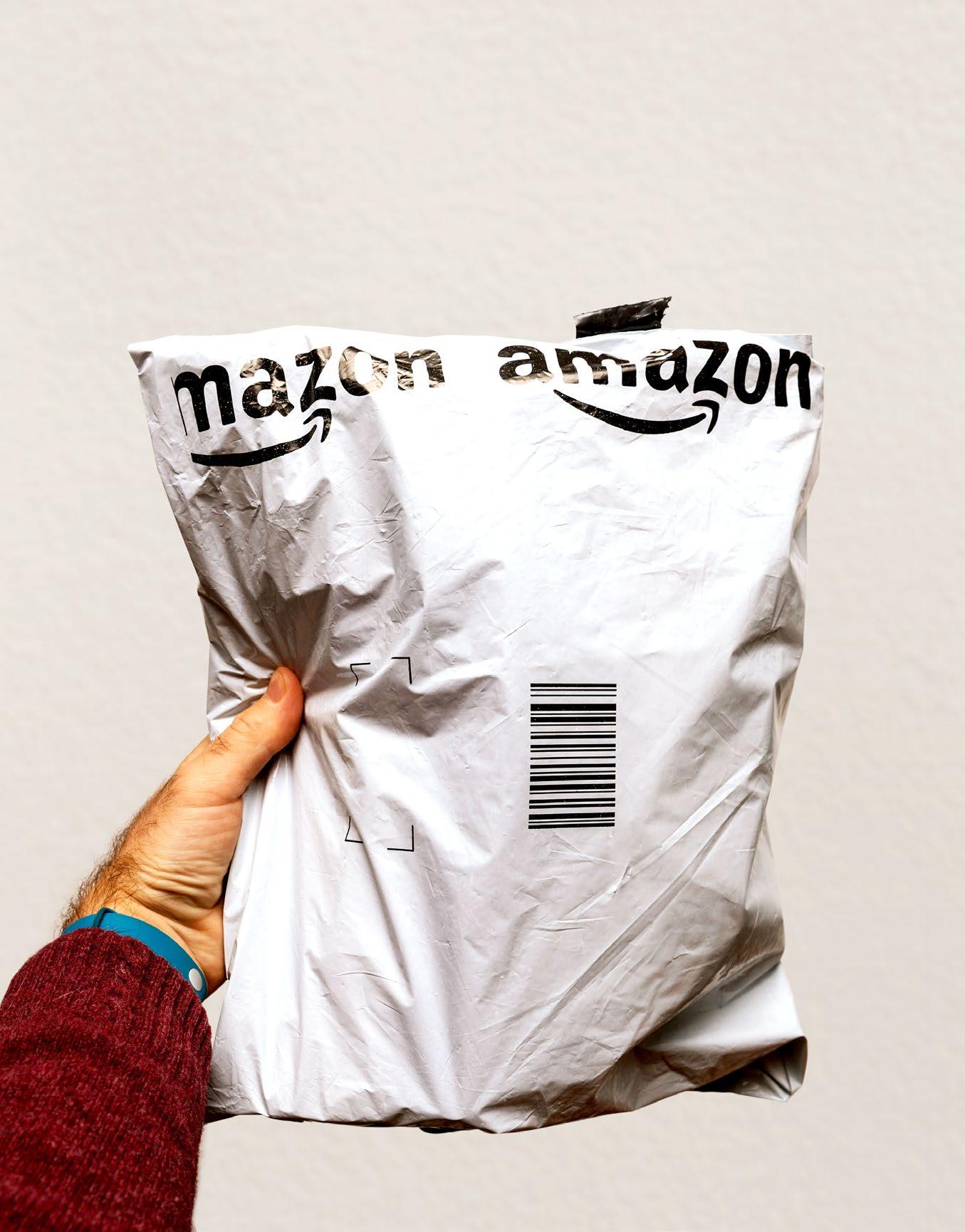
© Shutterstock/Hadrian Feature

it be nice if Amazon let its customers choose plastic-free packaging?
Wouldn’t
Well, Oceana has a campaign for that.
11 WINTER 2020 | Oceana.org
Opting Out
a special trip to bring their plastic packaging to a grocery store to be recycled, according to a new Oceana poll.
Amazon’s bubble-lined plastic mailers aren’t accepted by most curbside
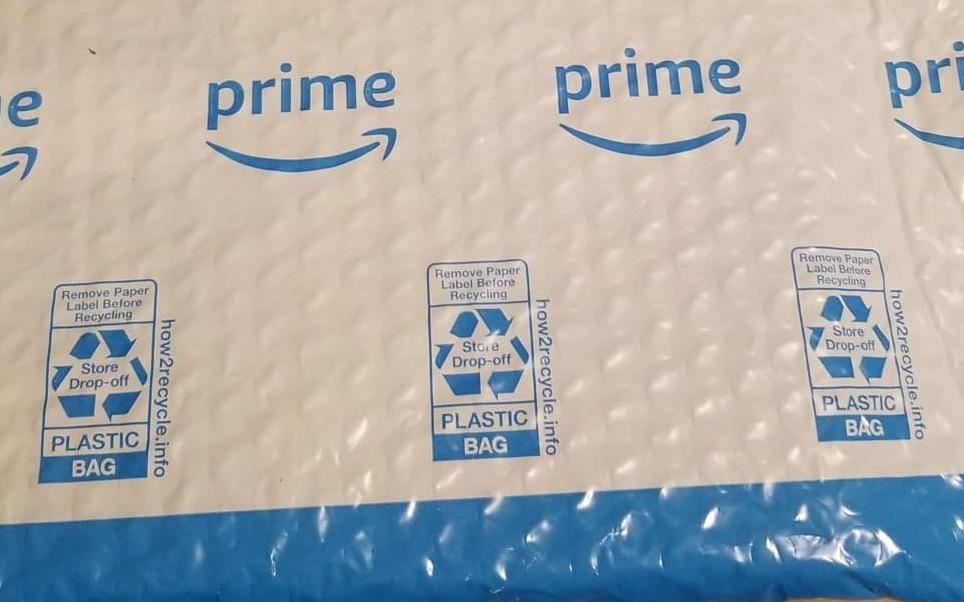
because they’re notorious for jamming recycling machinery.
If convenience is what you value most in a shopping experience, you’d be hard-pressed to find a better outlet than Amazon. With millions of products, fresh groceries, and same-day delivery right to your doorstep, it’s no wonder that Amazon has become the world’s largest online retailer, delivering 7 billion packages last year alone. That is roughly one package for every person on the planet.
But once those packages have been opened and the thrill of a new purchase subsides, a sobering question settles in: What will happen to all the plastic left behind? None of those plastic bags, bubblelined mailers, or inflatable “air pillows” are recycled – at least not in any practical sense.
This essentially gives eco-conscious customers two options. One is to chuck your plastic waste in the trash bin, then try to shake off the guilt. The other (if you live in the U.S. or Canada) is to visit how2recycle.info, enter your zip code, and take a trip to the nearest
drop-off center that’s willing to accept your “flexible plastics,” which must be processed separately because they jam recycling machines.
For customers in rural areas, this is asking a lot. To give one example, residents of Calistoga, California, must drive nearly 22 miles to a Target store to offload their otherwise unrecyclable plastics. Overall, less than 2% of Amazon Prime customers in the U.S. made
But there’s a third possible option, and it’s one that wouldn’t force customers to make difficult decisions or spend their Saturday mornings schlepping bags of plastic packaging to the supermarket. Once customers reach the checkout page, Amazon could let them tick a box to opt for plastic-free packaging. This is the option that Oceana is advocating for through its new campaign, launched last summer to address the increasingly pressing need for Amazon to provide plastic-free alternatives.
Amazon said in its second quarter earnings report that its sales had increased by 40% (compared to the same quarter the previous year). This is partly because, in the midst of a global pandemic, many people have been shopping online instead of at brick-and-mortar stores.
Considering that “the new normal” will soon be carried over to a new year, it seems likely that the deluge of Amazon packages – and plastic packaging – will only get worse.
packages don’t need to be made of plastic. The scientists and engineers at Amazon’s lab have already created lightweight, plastic-free packaging, including a new paper-based mailer that has been used over 100 million times, according to the company.

12
Feature
recycling programs
© Haley Martin
Amazon’s
© Shutterstock/Hadrian
Amazon’s ‘plastic footprint’ A plastic-free packaging option would go one step further and let shoppers avoid the types of plastic that all too often end up in the ocean.
Of all the plastic waste ever generated, only 9% has been recycled, and only 10% of that waste was recycled a second time. Some plastic is incinerated (which carries its own set of problems), but most of that waste ends up in landfills or natural environments, including our oceans.
Given these statistics, and the difficulty of recycling Amazon’s plastic packaging in the first place, there’s no guarantee that all those air pillows and plastic mailers will be kept out of marine environments.
“There is a high risk that Amazon’s plastic packaging will end up in the oceans because it is practically not recycled,” said Oceana Director of Strategic Initiatives Anne Schroeer.
“It takes just one plastic bag, mistaken for food, for a sea turtle to die. We need Amazon to do what they do best: imagine the unimaginable, invent and innovate, reduce their plastic footprint, and switch to reusable packaging to end this cycle of waste.”
Oceana believes Amazon should ship more packages in reusable containers and limit the amount of extraneous packaging they use, in addition to giving customers a plastic-free packaging option at checkout.
Giving customers a say in their preferred packaging materials would not be a huge stretch for a company of Amazon’s size and influence. Amazon customers are already able to customize some of their shipping preferences and ask that items be sent in fewer boxes. Recently, the company even unveiled a “Climate Pledge Friendly” label for products that meet certain environmental standards.
In fact, this is an option that customers want. When Oceana polled Amazon shoppers in the U.S., UK, and Canada, it found that 86% are concerned about plastic pollution and 87% think major online retailers like Amazon should curb the amount of plastic packaging they use.
Delma said. “That’s when I realized that it was such a prevalent and lasting issue.”
Indeed, plastic has been found in the deepest parts of the ocean, including the Mariana Trench at 36,000 feet down. While Amazon is not the only company that uses plastic packaging, it’s one of the largest – and Delma thought it was a pretty good place to direct her efforts.
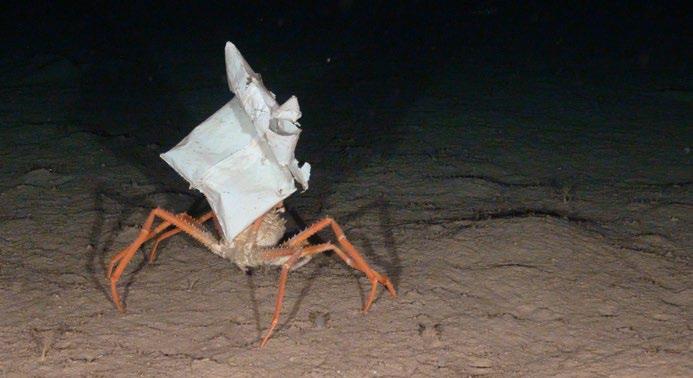
Like many Amazon shoppers, marketing strategist and conservationist Nicole Delma isn’t thrilled when she gets a package brimming with plastic. Delma became acutely aware of the plastic pollution crisis 20 years ago, when she appeared on a reality TV show that many are familiar with.
“I was filming a show called Survivor in Panama, in what was supposedly a completely untouched part of the Earth, and there was a tremendous amount of man-made plastic inland and in the water, even back then,”
So she created an online petition – available at Change.org/ PlasticFreeChoice – calling on Amazon to offer plastic-free packaging options. It has garnered more than 630,000 signatures, and the list of names continues to grow each day.
“I’m an Amazon customer – most everyone I know is an Amazon customer – and I think that there’s not really any plan for people to change the way that they’re consuming,” Delma said.
“But we’re at a crossroads now where we’re realizing, ‘What is the cost of that convenience?’ We can’t have everything that we want at our fingertips without there being some fallout from it.”
WINTER 2020 | Oceana.org13
‘We’re at a crossroads’
Plastic can harm a wide array of ocean animals. Ingestion can interfere with feeding and respiration, while entanglement can lead to infected wounds and drowning.
© EU Oceana
Amazon India’s example with – either their own suppliers or those that sell on the Amazon Marketplace – to package items in a certain way.
One need not have an overactive imagination to envision a scenario where Amazon replaces its plastic packaging with more sustainable alternatives. All you need to do is look east. As of June 2020, Amazon has eliminated non-recyclable plastic from its fulfillment centers across India. Corrugate boxes have taken the place of plastic mailers, paper cushions have replaced air pillows and bubble wrap, and packages are sealed up with biodegradable tape.
This decision followed Indian Prime Minister Narendra Modi’s vow to ban single-use plastics, which are not easily processed in India due to a lack of facilities. Roughly 77% of the country’s plastic ends up in massive trash heaps, with one of New Delhi’s landfills standing about as tall as the Taj Mahal.
“I urge the start-up founders, technicians, and industrialists to find ways to recycle plastic,” Modi said in a speech last year. “Singleuse plastic is the root cause of many of our problems – but the solution has to come from within, from us.”
Given that India is the second most populous country in the world, Amazon’s decision to eliminate non-recyclable plastic nationwide was no small feat. However, former Amazon executive Rachel Johnson Greer believes that Amazon could easily replicate this success in the west. She explained that Amazon can instruct the companies it works

“If Amazon were to tell its sellers tomorrow, ‘You have to do 1, 2, 3,’ they would comply, and I think most sellers would be perfectly fine not having plastic packaging,” she said. “Amazon has the technical ability with its fulfillment centers to offer plastic-free alternatives to its customers, reduce plastic, and help protect the oceans and the environment. It is really a question of will.”
As a former Amazon executive, Rachel Johnson Greer spent nearly a decade working in the company’s regulatory and product development divisions. She then went on to become a leading consultant, advising companies on how to successfully sell on Amazon’s Marketplace.
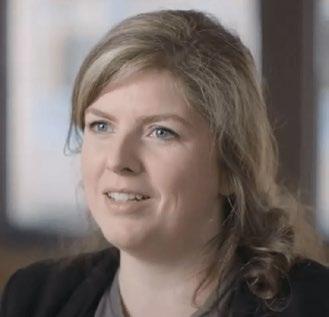
14 Feature
These paper envelopes would be perfectly recyclable were it not for their bubble wrap linings. As soon as plastic is added to the mix, this envelope is given a one-way ticket to the landfill. This is because mixed materials are especially difficult to recycle.
© Shutterstock/Hadrian
Single-use plastic is the root cause of many of our problems – but the solution has to come from within us, from us.
Indian Prime Minister Narendra Modi
“ “
Just as sellers listen to Amazon, Amazon listens to its customers. As Greer put it, “Customers are everything to Amazon. They’re as close to a monopoly as possible because they care about customers.” CEO Jeff Bezos has previously said that Amazon is “obsessed” with meeting the needs and wants of its customers, and the time has come to put that promise to the test.
In addition to signing Delma’s petition, you can take action by making your voice heard on social media. Tell Amazon and Bezos that you want a plastic-free packaging choice by tagging or mentioning them in your posts with the “@ amazon” handle on Instagram, Facebook, and Twitter, as well as the “@jeffbezos” handle on Instagram and Twitter.
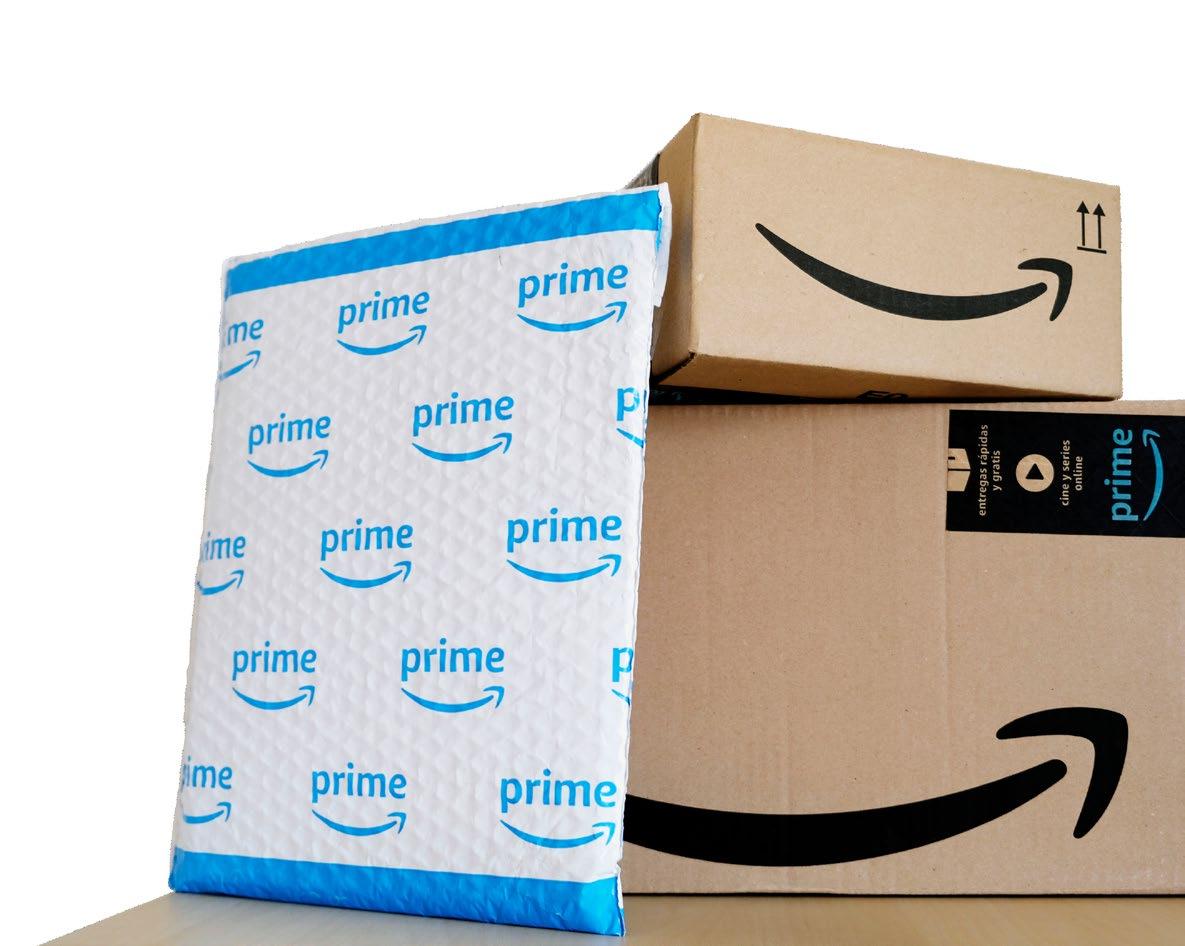
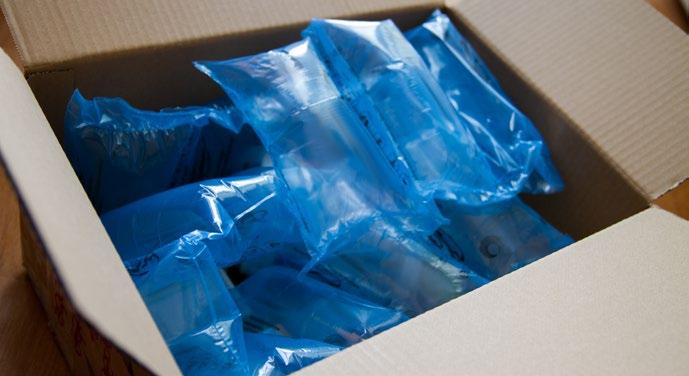
With single-use plastics taking an ever-increasing toll on the planet, we cannot afford to wait for another 7 billion (or more) Amazon packages to be shipped next year. Amazon owes its success to its customers, and those customers deserve a plastic-free packaging choice at checkout. For a global giant like Amazon, this is a small ask – but it’s a change that would make a world of difference to the oceans.
Rachel Johnson Greer, former Amazon executive
15 WINTER 2020 | Oceana.org
A prime time to speak out
Customers are everything to Amazon. They’re as close to a monopoly as possible because they care about customers.
“ “
Air pillows are now ubiquitous, especially in Amazon packages. Even when reused, their life span is relatively short because they can deflate.
© Shutterstock/PippiLongstocking
© Shutterstock/Maryna Marchenko
Belize tackles a triple threat
Oceana and its allies successfully fought to ban bottom trawling and offshore drilling in Belize. Now, harmful gillnets are being blown out of the water, too.
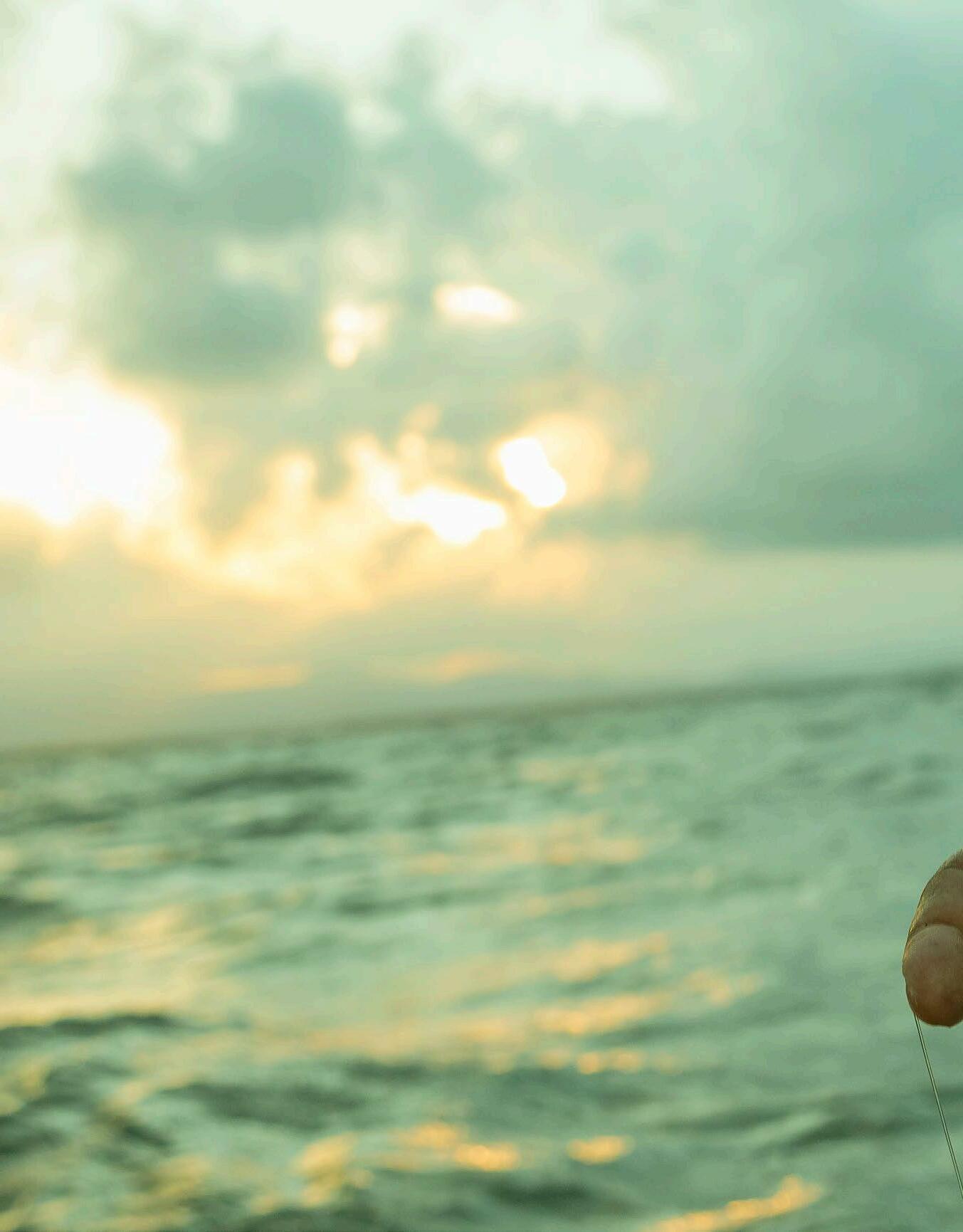
Feature © Oceana/Alex Ellis

17
2020 | Oceana.org
Local fishers drop a line off the coast of Belize’s Tobacco Caye. Most Belizean fishers use sustainable fishing methods like line fishing, but a small number of gillnets have continued to plague local marine life and habitats - until now. WINTER
For a country that’s slightly smaller than the U.S. state of Massachusetts, Belize boasts an inordinate number of ocean wonders. It’s home to the world’s second longest barrier reef, which Charles Darwin once described as “the most remarkable reef in the West Indies.” Here, you’ll find more than 500 unique fish species – enough to give every Belizean island its own mascot and still have about 50 left over.
Because this little Caribbean country has a lot worth protecting, it has enacted some of the strongest ocean conservation laws in the world – and they just got even stronger. Following hardfought victories that banned all trawling and offshore oil drilling in Belize’s waters, the country has now outlawed gillnets, a fishing gear that kills turtles, manatees, and many other marine animals.
In addition to implementing a nationwide gillnet ban, the Belizean government signed an agreement
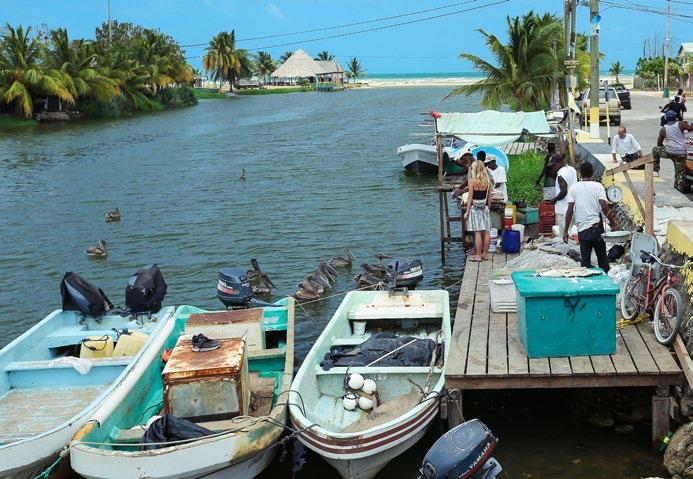
with Oceana and the Coalition for Sustainable Fisheries to help licensed gillnet fishers transition to other jobs.
As a result, Belizean waters will be protected well into the future.
In the words of Janelle Chanona, Oceana’s head in Belize, “This is a historic moment for Belize, her people, the Caribbean Sea and, most importantly, for everyone who depends on the country’s marine resources for their livelihoods.”
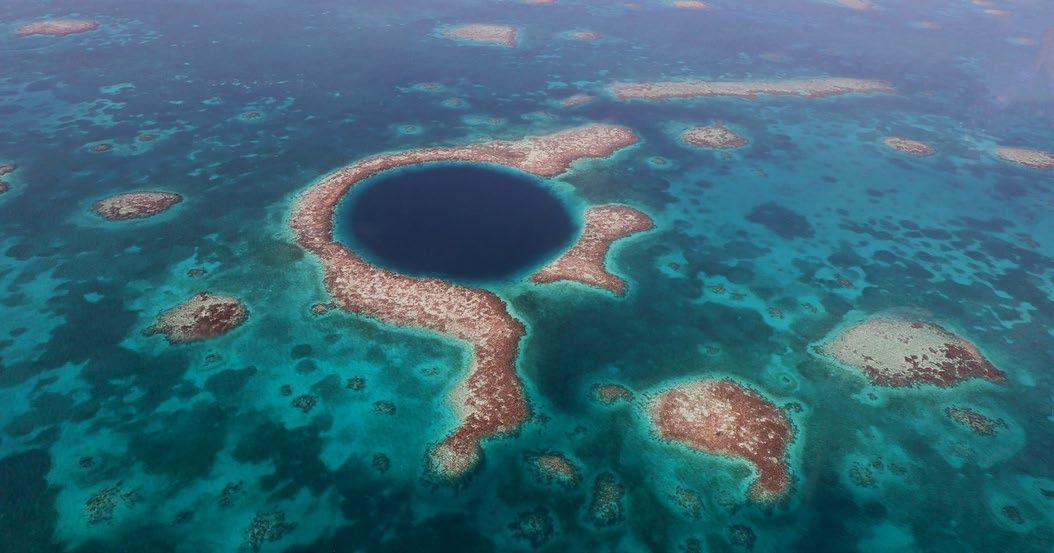
18 Feature
A landing site and fish market is photographed in Dangriga, a town in southern Belize. Fisheries accounted for 3% of Belize’s gross domestic product (GDP) in 2015.
© Oceana/Alex Ellis
Belize’s Great Blue Hole, a massive marine sinkhole and World Heritage Site, is one of the many remarkable features that benefits from stronger ocean protections.
© Oceana/Alex Ellis
Walls of death of endangered shark – have fallen victim to gillnets. In 2015, a rarely seen scalloped hammerhead got tangled up in a gillnet and drowned, making local headlines and sparking outrage. Gillnets have also ensnared critically endangered sawfish, a unique ray with a long snout and sawlike teeth that is said to be locally extinct.
To say that gillnets harm marine life would be putting it delicately. The reality is far grislier. Nicknamed “walls of death,” these nets, which can measure a mile long when linked together, are indiscriminate in what they catch. They’re designed to snag fish by their opercula – the plate that protects their gills, also known as a gill cover – but they also trap non-targeted animals. (For more on how they work, read Dr. Daniel Pauly’s column on page 26). Once ensnared, an animal might suffocate to death because they can no longer push air through their gills, or because they cannot resurface to breathe.
Many of these dead animals are chucked back into the ocean because they can’t be sold for profit. In Belizean waters, protected species like bonefish, tarpon, and manatees – and at least one species
For Lowell “Japs” Godfrey, a former gillnetter in Belize, the carnage and wastefulness were too much
to bear. He handed over his net more than a decade ago and never looked back, instead switching to sustainable seaweed farming.
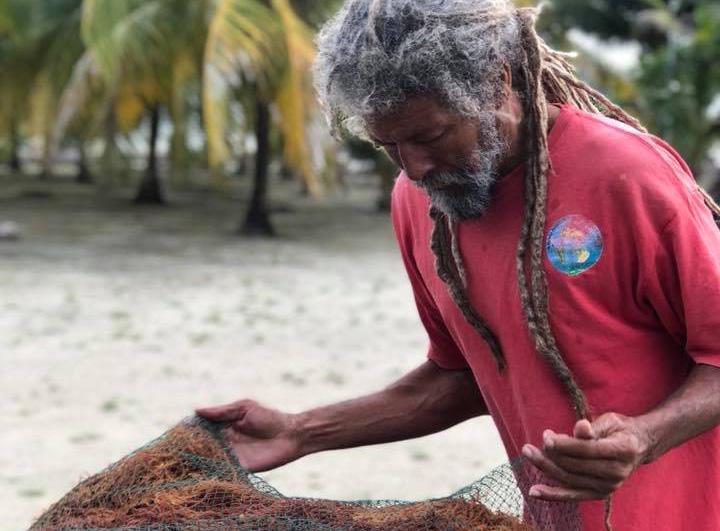
“With gillnets we have a lot of stuff that we just dump because we kill it, and we don’t use it,” Godfrey said. “That is one of the things that caused me to back off [from using gillnets]. I use [my vocation] not only to earn money, but to educate myself about the marine environment.”
“Japs” Godfrey, former gillnetter
WINTER 2020 | Oceana.org19
Lowell “Japs” Godfrey is a leading expert on seaweed farming in Belize. He has worked hard to protect marine ecosystems, and in recognition of his tireless efforts, he received an Ocean Hero Award from Oceana in October 2020.
© Jenna Godfrey
With gillnets we have a lot of stuff that we just dump because we kill it, and we don’t use it. That is one of the things that caused me to back off [from using gillnets].
Lowell
“ “
Godfrey’s career change was part of a larger trend. Gillnetting has fallen out of favor, and nowadays, fewer than 100 licensed gillnetters remain in Belize. In fact, less than 3% of commercial fishers in Belize use gillnets, and some Belizean fishers have been backing a gillnet ban for more than 20 years.
The problem persists, in large part, because gillnetting is the “gear of choice” for illegal fishers, according to Chanona. Many gillnetters are coming from neighboring countries and fishing illegally in Belizean waters, then swinging by other countries’ ports to sell their catch. Doing so depletes Belize’s ocean and deprives local fishers and tourism workers of income that hinges on abundant oceans.
“COVID has reminded us that fishing-based income is more important than ever to protect,” Chanona said. “Foreign gillnetters come to their favorite fishing spot in Belize, then take all their marine products to ports in Guatemala and Honduras. Even though they are fishing in Belizean waters, none of the fruit of that labor comes through the legal economy here in Belize. Belizeans will have nowhere to fish if everything is depleted by destructive fishing practices.”
Illegal gillnetters are believed to target sharks, which are not widely eaten in Belize but are in considerable demand in Guatemala and Honduras, especially during the Catholic Lenten season when observers abstain from eating land-based animals. They are also believed to fish in marine reserves. Because these products are not processed at Belizean ports, there’s no record of what’s been removed from the ocean, potentially putting some species at risk of overfishing.
Playing by new rules
Under a Belizean law passed last year, all commercially licensed fishers must meet new requirements: They must be Belizean citizens who have lived in Belize for the last six months, and they must sell their products exclusively in Belize. Gillnetters who held licenses in 2018 must also meet these requirements to qualify for funding that would help them transition to another field of work.
Now that a ban is enacted, gillnet fishing in Belize’s maritime territory,

including its Exclusive Economic Zone, is illegal and subject to penalties and fines. If anyone participating in the transition program is convicted of illegal fisheries activities, the financial support would be rescinded immediately.
But before these transitions occur, a panel of representatives from the government, Oceana, and the Coalition for Sustainable Fisheries must vet everyone who held a gillnet license in 2018. Tracking them down, however, may take a bit of detective work.
20 Feature
‘Gear of choice’ for illegal fishers
Foreign gillnetters come to their favorite fishing spot in Belize, then take all their marine products to ports in Guatemala and Honduras. Even though they are fishing in Belizean waters, none of the fruit of that labor comes through the legal economy here in Belize.
Janelle Chanona, Oceana’s head in Belize
“ “
Gillnets are pictured in a boat in Belize’s Riversdale village. Gillnets can be destructive even when they’re lost or forgotten in the water because they continue to catch animals. This phenomenon is known as “ghost fishing.”
© Oceana/Alex Ellis
Wanted: Missing fishers
There are 83 gillnetters who are potentially eligible for the transition program. But because this list of names was compiled in 2018, some of the gillnetters have since died, and others have seemingly vanished. In September, Oceana paid to have full-page ads – containing the names of 28 missing gillnetters – placed in local newspapers.
“NOTICE,” the ad reads in big, bold letters beneath the country’s coat of arms. “The Ministry of Fisheries, Forestry, the Environment and Sustainable Development (MFFESD) is attempting to locate
the following persons who possessed gillnet fishing licenses in 2018.”
The ad then lists the phone numbers of government officials who can be contacted to “discuss possible eligibility for support related to the phase-out and ban of gillnets in Belize.” A handful of responses have trickled in, but some are still nowhere to be found.
Because Belize has so many remote cayes, or islands, it’s easy for fishers to illegally enter Belize, set up camp on an offshore island, fish to their hearts’ content, and return to a foreign port without ever encountering any authorities.
“It’s definitely strange if we can’t find someone,” Chanona said. “Belize is a small country where everybody knows everybody, and if we still can’t locate them after active questioning and investigations at the community level, that’s another indicator that they are spending the majority of their time offshore.”
Charting a new course
Fortunately for the legally licensed gillnetters who will be swapping out their old careers for new ones, they won’t be complete guinea pigs, nor will they be going it alone. Many Belizean fishers have already given up their gillnets – voluntarily – to protect the home that they love. Lowell Godfrey’s road to success is paved in seaweed, but many former gillnetters have also become fishing guides.
Tourism has become one of Belize’s most lucrative – and popular –industries, but the Coalition for Sustainable Fisheries plans to make a couple different career paths available to gillnetters. The Coalition, which is leading the
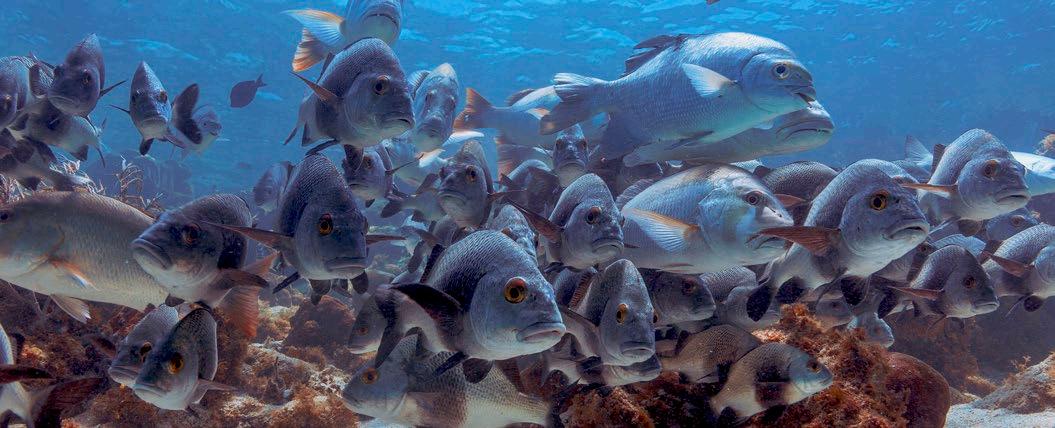
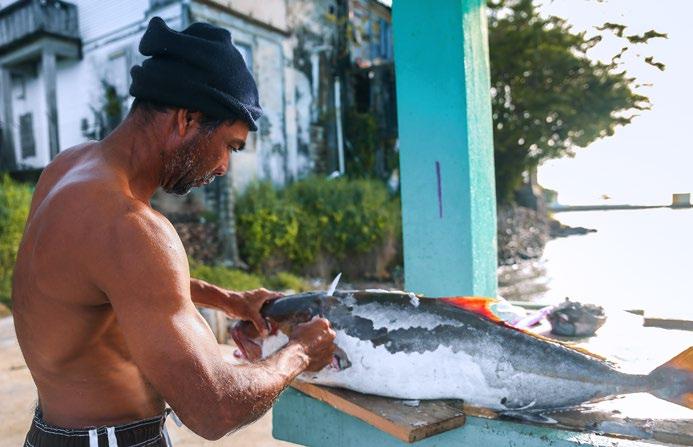
WINTER 2020 | Oceana.org21
A fish is cleaned in Punta Gorda, a fishing town in southern Belize. Fishers played an instrumental role in helping Oceana and its allies secure a gillnet ban in Belize.
© Oceana/Alex Ellis
Belize’s Hol Chan Marine Reserve, pictured here, is a popular diving and snorkeling site. The tourism industry, which supports (either directly or indirectly) more than 30% of all jobs in Belize, also benefits from a gillnet ban.
© Oceana/Alex Ellis
retraining and transition process, is developing one training program for tourism and another for shrimp fishing. The latter would teach fishers how to use small traps – a far cry from the harmful trawls that industrial fishers use (the likes of which have been banned in Belize).
When all is said and done, fishers will have new vocations that not only provide income, but also instill pride and maintain their dignity as providers for their households, Chanona said. As stewards of Belize’s ocean, they will be doing their part to protect and preserve it for future generations.
“This is as much a victory for Belize as it is a testament to the perseverance of the local fishers who have overwhelmingly opposed this destructive fishing gear for decades,” Chanona said. “Every law, policy, or regulation that protects Belize’s marine resources is a win for the tens of thousands of Belizeans who depend on those resources for their food, their jobs, and their way of life.”
gillnets
Belize isn’t the only place celebrating a major milestone in the fight against gillnets. In the U.S., Oceana recently hit its target of raising $1 million from foundations, families, and individuals to help remove deadly drift gillnets from Californian waters. According to a state law, which Oceana helped pass in 2018, these donations will put an end to the fishery in four years. The state has matched these funds, which are being used to compensate fishermen who voluntarily hand over their gillnets and give up their corresponding permits.
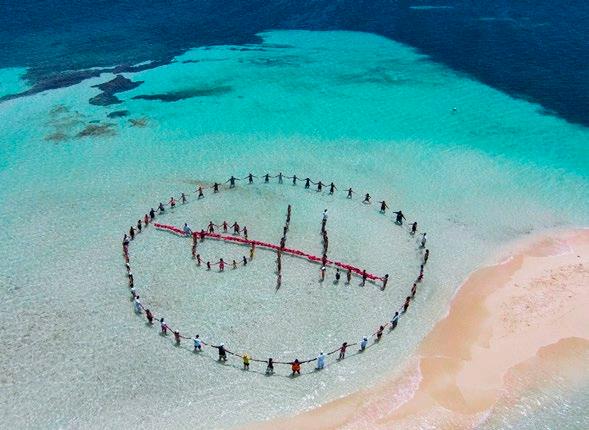
Much like the situation in Belize, these nets are notorious for injuring and killing marine life in California, including whales, dolphins, sea lions, sea turtles, sharks, and other important fish species. For years, the fishery killed more dolphins than all other U.S. West Coast and Alaska fisheries combined. Over 90% of the remaining active drift gillnet fishermen have indicated they will participate in this program, and the first batch of nets and permits were relinquished in August 2020. Participating fishermen will be first in line to get federal permits for deep-set buoy gear, an alternative fishing method that is more effective at catching swordfish while avoiding non-targeted species.
This funding was made possible thanks to generous donations from the Marisla Foundation, Cinco Hermanos Fund, Offield Family Foundation, and Sue J. Gross Foundation, as well as several families and individuals.
“We are so thankful to the donors who generously contributed funds toward this innovative transition program that will save whales, sea turtles, and other ocean wildlife by removing harmful drift gillnets from our oceans, and provide opportunities for California fishermen to catch swordfish with more selective methods like deep-set buoy gear,” said Dr. Geoff Shester, Oceana’s California campaign director. “We commend local fishermen for being part of the solution and are glad to see them receive financial assistance during these challenging times.”
22 Feature
California comes one step closer to eliminating deadly drift
Every law, policy, or regulation that protects Belize’s marine resources is a win for the tens of thousands of Belizeans who depend on those resources for their food, their jobs, and their way of life.
Janelle Chanona, Oceana’s head in Belize
“ “
Oceana Wavemakers in Belize banded together to protest offshore oil exploration. In 2017, Belize became the first country in the world to completely ban offshore oil and gas development.
© Oceana/Alex Ellis
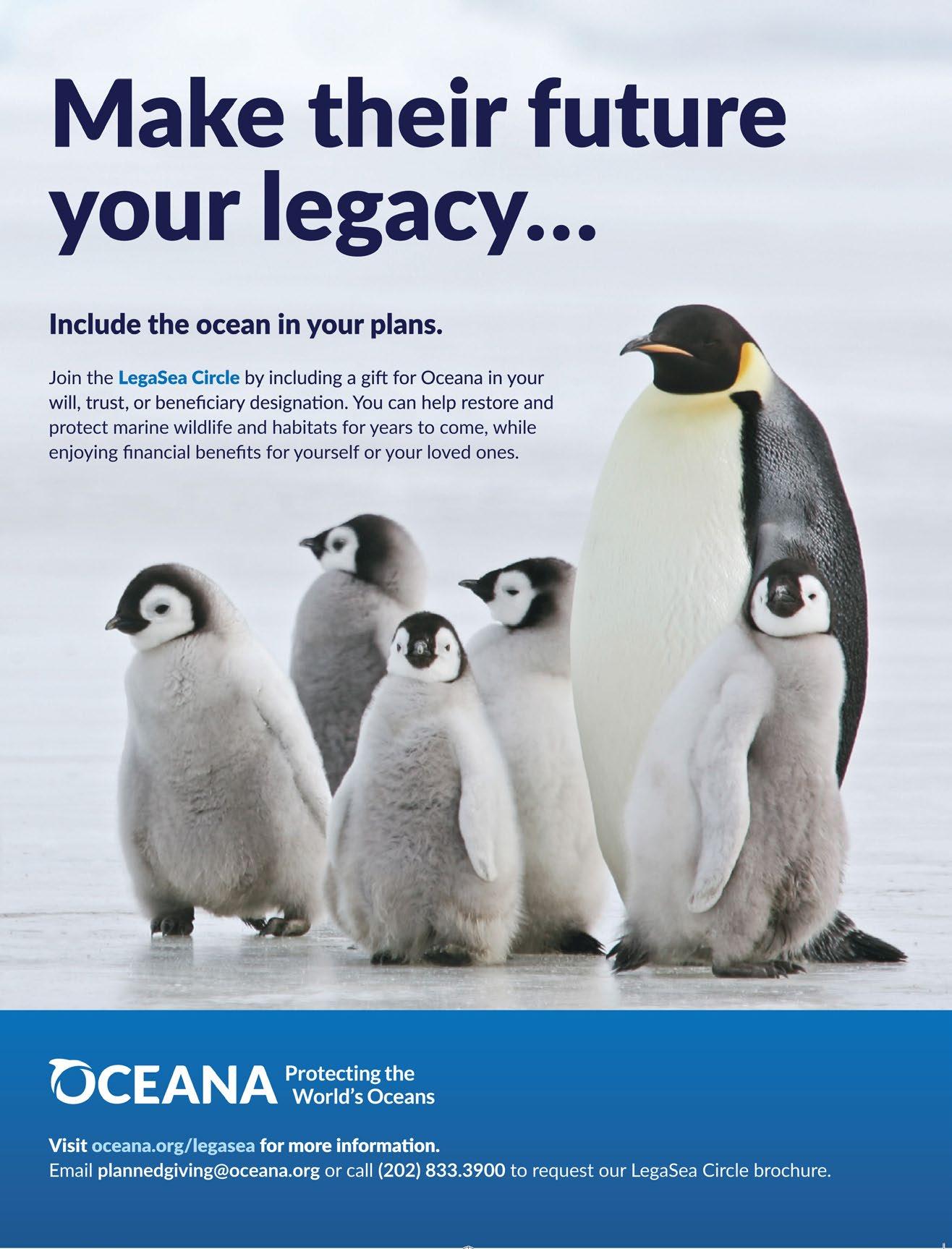
Our victories over the last year
Government of Belize bans gillnets
Brazil launches online logbooks for its fisheries catch data

Chile prevents the construction of harmful salmon farms in Patagonia
New York bans plastic foam food containers and packaging
U.S. government protects whales and sea turtles in California-based fishery
Belize phases out single-use plastics and Styrofoam
New U.S. protection will save sea turtles from dangerous shrimp trawls
24 © Oceana/Keith
Ellenbogen
Supporter Spotlight
Year after year, BMW drives support for Oceana’s campaigns

BMW specializes in crafting vehicles that can comfortably cross large swaths of land, but the company is also quietly driving change in the world’s oceans. Over the last eight years, the luxury brand has raised nearly $500,000 for Oceana’s campaigns by donating hybrid and electric cars to the live auction portion of the SeaChange Summer Party.
This year’s auction was held virtually for the safety of guests and talent amidst the COVID-19 pandemic, but the online iteration was no less successful (for more on this event, see page 28). Thanks to BMW’s generous donation of an X3 xDrive30e sports activity vehicle – a new Plug-in Hybrid Electric Vehicle (PHEV) in the brand’s 2020 lineup – an additional $48,750 will go toward saving marine life and rebuilding ocean abundance.
“Despite the challenging circumstances this year, we’ve been thrilled to continue our partnership with Oceana and support their valuable mission,” a company representative said.
“Sustainability is a central value for BMW at a global level, and with California often leading the way in terms of environmental causes and conservation efforts, it made complete sense to partner with an organization like Oceana which shares that same focus.”
This annual car donation is made possible by Oceana’s partnership with Southern California BMW Centers. Once the donated cars are auctioned off, the money goes toward general operating support of Oceana campaigns in California and around the world. For example, this could cover campaigns that protect whales and habitat, increase transparency, or promote science-based fishery policies.
Previous donated cars have included the electric i3 and plug-in hybrid electric i8, 745e, 530e, and 330e models. These models are part of a lineage of innovation that can be traced back more than 40 years. The first all-electric BMW made its debut in 1972 – a year before the global oil crisis dominated headlines – at the Olympic Games in Munich, Germany.
Nowadays, electric vehicles are often touted for their ability to reduce carbon emissions. Carbon dioxide not only contributes to global warming, but also harms our oceans in complex and myriad ways.
“Electric vehicles hold a lot of potential for helping the U.S. create a more sustainable future,” according to the U.S. Department of Energy. “If the U.S. transitioned all the light-duty vehicles to hybrids or plug-in electric vehicles, we could reduce our dependence on foreign oil by 30-60%, while lowering the carbon pollution from the transportation sector by as much as 20%.”
BMW has also taken action to convert some of its operations to clean energy as part of its sustainability platform. At BMW’s factory in Leipzig, Germany, the assembly process is powered by wind turbines.
As the company continues to bolster its electric car portfolio, it is also championing ocean health through its support of the Paris Agreement. According to a study led by Oceana Board Member Dr. Rashid Sumaila, the Agreement has the potential to protect 3.3 million metric tons of ocean catch – more than the average annual catch of Norway – as well as $4.6 billion in fishing revenue.
“We’re rapidly electrifying our entire range of vehicles in line with our global company commitment to the 2015 Paris Climate Accord, and our company is sincerely committed to generating positive change and improving sustainability,” a representative said, “so we’re looking forward to what we can achieve together with Oceana in the future!”
WINTER 2020 | Oceana.org25
A donated BMW vehicle is pictured at Oceana’s SeaChange event in 2014.
© Ann Chatillon
Ask Dr. Pauly How do gillnets work?
There are different ways to catch fish, and their differences are as useful to know as that between hunting rifles and AK47s. In principle, gillnets should be highly selective, i.e., catch fish of a particular species and size, and avoid undesired fish.
Fish are caught in a gillnet that hangs down stiffly when they have a head small enough to enter the mesh of the net, but a body too big to pass through that mesh; in this case, the fish get stuck – not by their gills, but by the posterior side of their gill cover (see arrow in Figure 1).
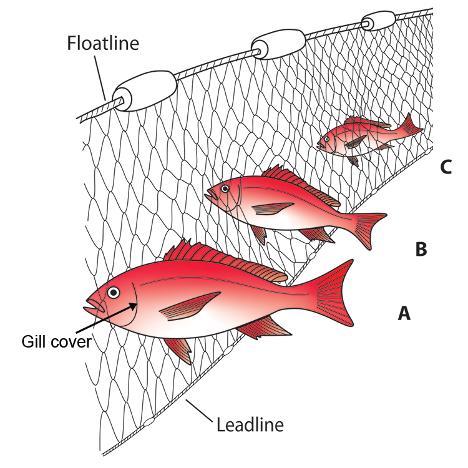
Also, in principle, smaller fish can pass through the mesh holes, and bigger fish would not be caught either because their heads could fit through the mesh, but their gill covers could not (again, see Figure 1).
However, this works only if the gillnets hang stiffly in the water column, either while they are anchored at specific spots or left to drift with the currents (in which case we speak of “driftnets”). If gillnets do not hang stiffly – and all fishers know how to make them hang loosely – they work as a swaying wall of death that entangles every animal, large or small, that pushes against their folds.
Thus, a gear designed to catch 20-inch snappers ends up catching
Figure 1. How gillnets are supposed to work: In Goldilocks-like fashion, big fish (see A) are not supposed to be caught because their heads are too big for the mesh of the net, while small fish (C) can swim through the net. Thus, in theory, when the net hangs stiffly (as can be ensured by a heavy “leadline”), only the fish that are not too big and not too small will be caught (B).
everything from 6-inch sardines to 6-foot-long sharks along with assorted sea turtles and dolphins. Or, put differently, a gear designed like a precision hunting rifle works like a forest-flattening bomb.
In response to the demand of fishers using selective gear, such as hooks and lines, and of civil society in Belize, a country for which marine fishes are a major touristic asset, Oceana has, for years, pushed for a nationwide gillnet ban. On August 20, 2020, the Government
of Belize signed a joint agreement to ban gillnets and offer fishers compensation to surrender their gear (for more details, read the feature on page 16).
There is also a global dimension to this: Very deep driftnets that had lengths of tens of miles were for decades commonly deployed in the high seas to catch tuna beyond the jurisdictions of coastal countries.
They were outlawed by the United Nations in 1989 because of the
26
26
damage they inflicted, but they continue to be used widely, albeit illegally. They are most often used to catch swordfish (and kill thousands of other marine animals), notably in the Mediterranean.
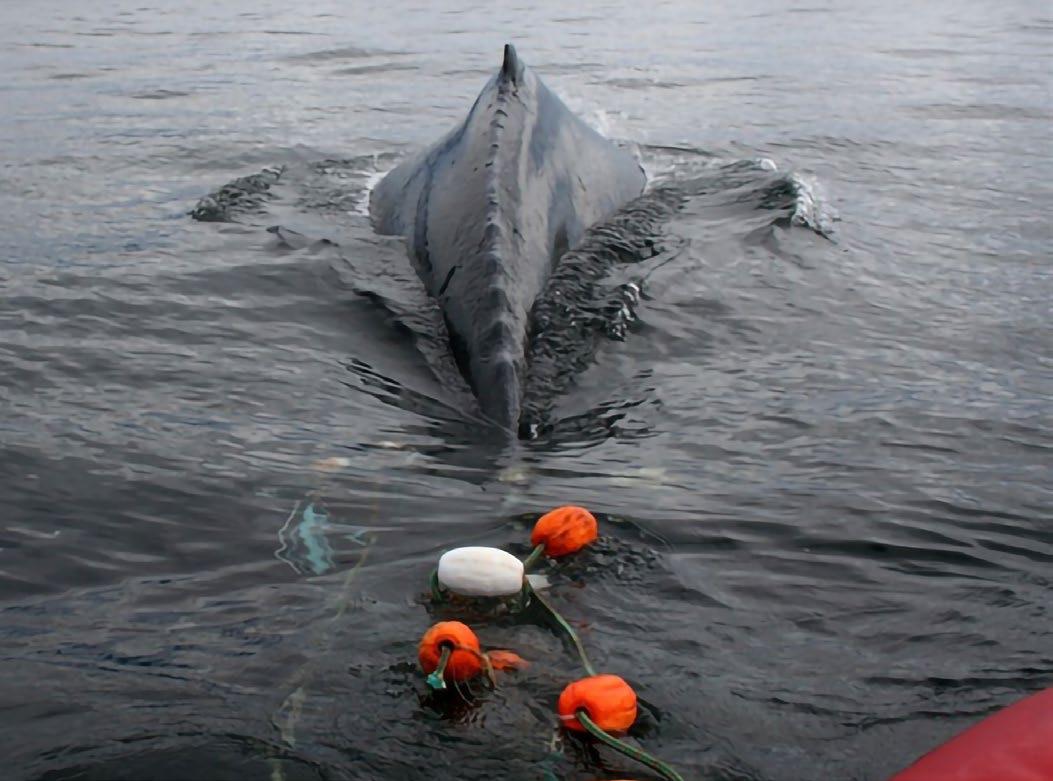
While a gillnet ban is a huge victory for Belize, this deadly gear is still
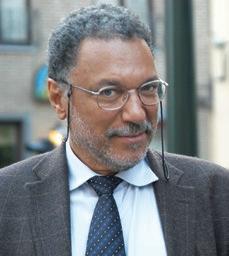
in use in many other parts of the world.
However, both Belize and the United Nations have shown, by outlawing giant driftnets, that it is possible to reverse course and protect marine diversity rather than mindlessly destroy it.
WINTER 2020 | Oceana.org27
WINTER 2020 | Oceana.org27
Dr. Daniel Pauly is the founder and director of the Sea Around Us project at the University of British Columbia’s Institute for the Oceans and Fisheries, and is a member of the Oceana Board.
How gillnets actually work: A humpback whale is shown entangled in a gillnet in Alaska’s Lower Chatham Strait.
© Aleria Jensen/NOAA
Both Belize and the United Nations have shown, by outlawing giant driftnets, that it is possible to reverse course and protect marine diversity rather than mindlessly destroy it.
“ “
SummerSeaChangeParty
On August 22, Oceana supporters tuned into the first-ever virtual SeaChange Summer Party: Home Edition. The annual event, which has been held 13 years in a row, went online this year in response to the coronavirus pandemic. Despite the challenging circumstances, SeaChange supporters exhibited their characteristic loyalty, confidence, and enthusiasm for Oceana and its mission by raising more than $940,000 for ocean conservation.
Actors, activists, and Oceana Board of Directors members Ted Danson and Sam Waterston hosted the evening, which was chaired by Elizabeth Wahler and vice-chaired by Jeff Blasingame. SeaChange 2020 featured a special address from Leonardo DiCaprio and a timely, tongue-in-cheek musical performance by Sting of The Police’s hit song Don’t Stand So Close To Me.
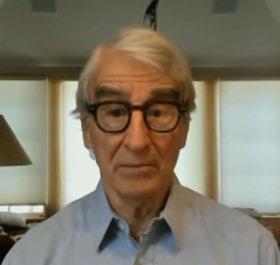

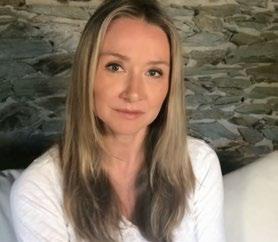
This year’s benefit focused on how protecting the world’s oceans and restoring abundance benefits both people and the planet. Despite the challenges, Oceana succeeded in winning numerous policy victories this year.
Oceana CEO Andrew Sharpless told SeaChange attendees, “I’m happy to report that despite the pandemic, economic shutdown, and all the tumult of this moment, together with our allies we have again delivered a set of policy outcomes that are protecting and restoring an abundant ocean.”
The SeaChange online auction featured an array of exclusive items, including a BMW X3 Hybrid SUV; a Lindblad Alaska Expedition; travel getaways to Montage Healdsburg, Ritz-Carlton Kapalua, Rosewood Miramar Beach, Pendry West Hollywood, and Park Hyatt Chicago; and luxury items from South Coast Plaza, Versace, Ralph Lauren, and Chopard.
Special thanks were given to the many businesses and philanthropists that made this event possible, including BMW and the Southern California BMW Centers, Dropps, the Harriett E. Pfleger Foundation, Jena King, Jean and Tim Weiss, Monique Bär, the Crevier Family Foundation, Tricia and Michael Berns, Laurie and Steve Duncan, the Marisla Foundation, Elizabeth Wahler, Valaree Wahler, and many other steadfast supporters.

The Oceana family also thanks the robust number of supporters from the entertainment community who played a role in this special Home Edition evening, including Oscar Nunez and Ursula Whittaker, Kate Walsh, Billy Magnussen, Austin Nichols, Christina Ochoa, Mirana Cosgrove, and Sam Trammel.

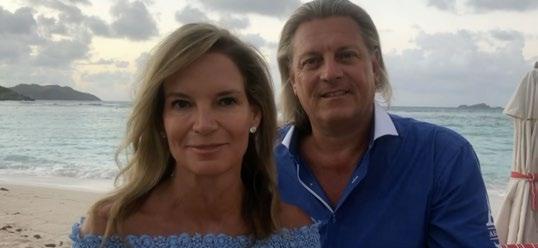
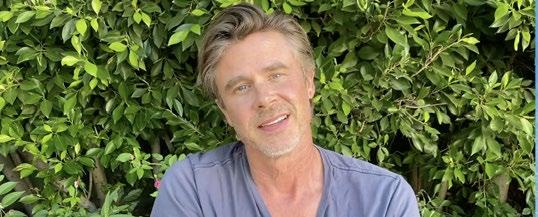
28
Events
Oceana Senior Advisor Alexandra Cousteau
Ocean Ambassador Austin Nichols
Oceana Board Member Ted Danson
SeaChange donors Janet and Carl Nolet
Oceana Board Chair Sam Waterston
Ocean Ambassador Sam Trammell
Ocean Ambassador Kate Walsh
Oceana Global Forum
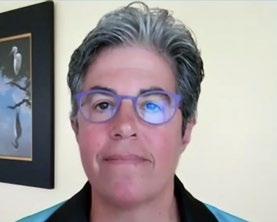


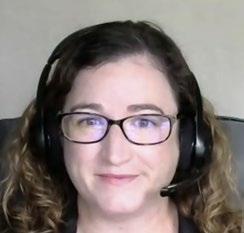


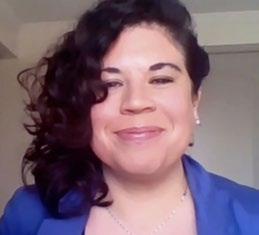
Oceana Board President Keith Addis hosted the inaugural Oceana Global Forum on September 26. The event was held virtually during a season that would normally be reserved for Oceana’s Rock Under the Stars event, “but this year is a very different year for so many reasons,” Addis told attendees during the Forum, which raised more than $600,000 for Oceana’s campaigns.
“Instead, we thought this would be a great opportunity, for the first time, for you to meet some of the incredible, talented Oceana team leaders from around the world and to hear about the intrepid work they’re doing to support the billions of people who depend on highprotein seafood meals every day and to sustain the millions of jobs that depend on healthy oceans,” Addis said.

The theme of the forum was “urgent issues of food security and livelihoods.” It featured a special message from Leonardo DiCaprio and a performance by Sting,

as well as updates from a number of Oceana’s leaders around the world. Presenters included Oceana’s CEO Andrew Sharpless, President Jim Simon, Chief Scientist Dr. Katie Matthews, Chief Policy Officer of North America Jackie Savitz, Chile Vice President Liesbeth van der Meer, Canada Executive Director Josh Laughren, Belize Vice President Janelle Chanona, Mexico Vice President Renata Terrazas, Pacific Deputy Vice President Susan Murray, U.S. Deputy Vice President Beth Lowell, Senior Advisor Philip Chou, and Senior Director of Advocacy for the European Union Vera Coelho.
Matthews’ presentation focused on tackling malnutrition with seafood. “We have a huge opportunity here,” Matthews said. “Ocean fish is a climate-smart, micronutrient-rich food. It requires no land or fresh water to harvest, both of which are at an increasing premium in this climate crisis, and there is more than enough of it to address the needs of vulnerable coastal populations if it can stay local.”
WINTER 2020 | Oceana.org29
Janelle Chanona, Oceana’s head in Belize
Oceana CEO Andrew Sharpless
Renata Terrazas, Oceana’s head in Mexico
Oceana President Jim Simon
Chief Policy Officer of North America Jackie Savitz
Oceana Board President Keith Addis
Senior Advisor Philip Chou
Liesbeth van der Meer, Oceana’s head in Chile
U.S. Deputy Vice President Beth Lowell
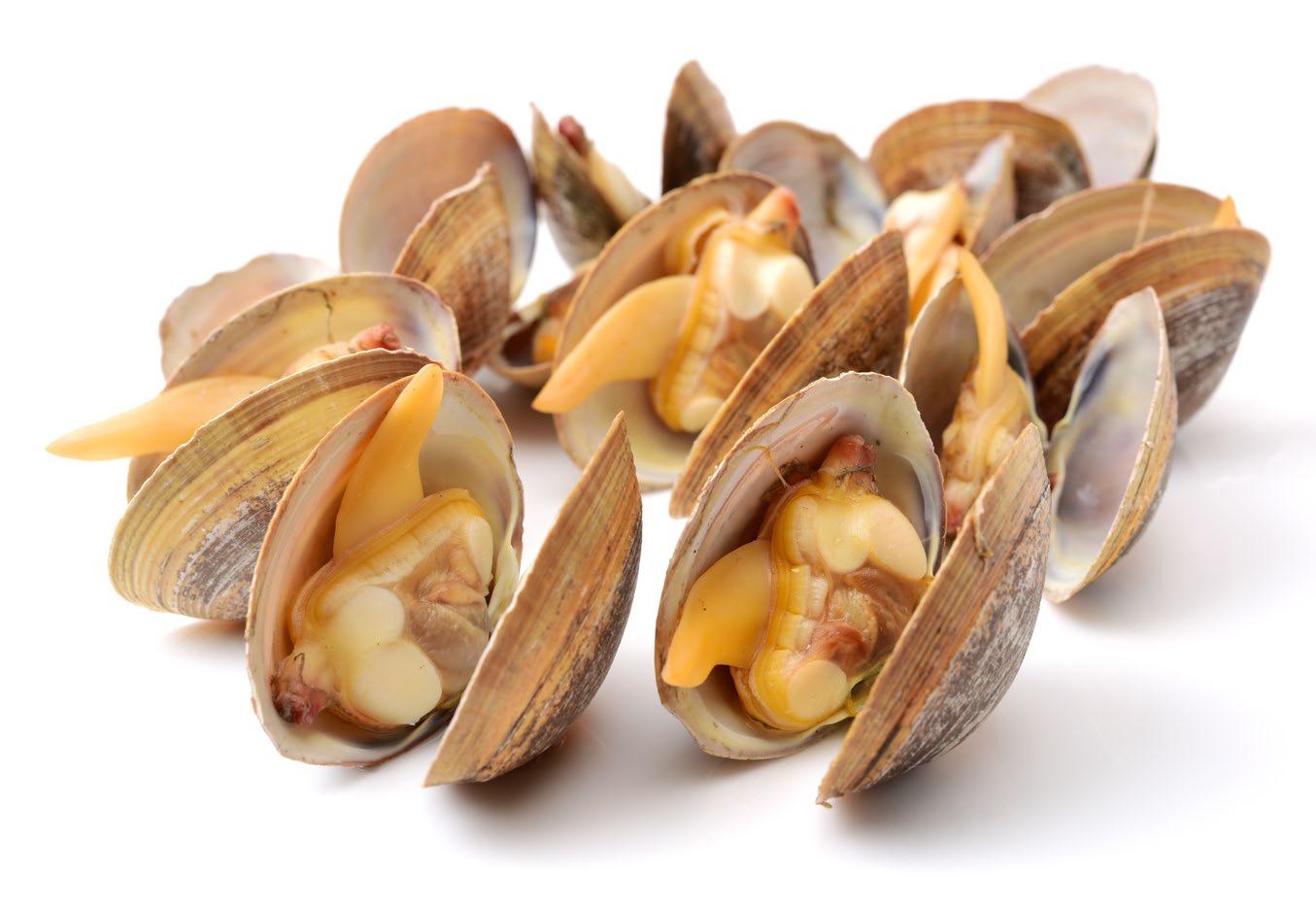
30 Chef’s Corner Clams © Shutterstock/Jiang Hongyan
filter feeder worth feasting on
A
Calamari may steal the show as Rhode Island’s official “state appetizer,” but fried squid isn’t the only sea creature adored by local gourmands. The equally iconic “state shell” comes from a type of clam called a northern quahog, otherwise known as a hard clam, round clam, or chowder clam (so-called because they’re often used in clam chowders).
Wild-caught Rhode Island quahogs, along with northern razor clams harvested from the Quinault Indian Reservation in British Columbia, Canada, are some of the most sustainable clams you’ll find in North America. Plucked from the sea with rakes, hoes, and shovels, Rhode Island’s clams are harvested in accordance with quotas and science-based fishery management. This is especially important because quahogs are slow-growing and take up to 20 years to reach a commercially harvestable size.
If you can’t find Rhode Island quahogs or Quinault northern razor clams at your local supermarket, any other variety will do. The Monterey Bay Aquarium’s Seafood Watch guide lists all clams as either a “best choice” or “good alternative,” and the latter list includes quahogs harvested in Maine, Massachusetts, New Jersey, New York, North Carolina, and the Gulf of St. Lawrence in Canada (where Oceana successfully advocated for the establishment of a marine protected area).
As Mark Bittman writes in the 20th anniversary edition of his book How to Cook Everything, different terms denote the varying textures and sizes of these meaty mollusks: “Clams range from little (littlenecks and Manilas) to sea clams that weigh hundreds of pounds; they may be hard (littlenecks, cherrystones, or the huge quahogs) or soft (steamers, razor clams, and other clams with fragile shells). The biggest and toughest are chopped into bits to be made into chowder. The choicest – essentially the smallest – are sold live and are great raw or briefly cooked.”
Whichever clam you choose, Bittman recommends pairing them with cold soba noodles and dipping sauce for a full meal; shucking fresh ones and eating them raw with lemon; or serving up a simple clam appetizer, like the recipe shown to the right.
Mark Bittman is an award-winning food journalist, author, and former columnist for The New York Times. He is a fellow at the Union of Concerned Scientists and a faculty member of Columbia University’s Mailman School of Public Health.
Baked Clams with Wasabi Bread Crumbs
From How to Cook Everything by Mark Bittman
Serves: 4 main-dish or 8 appetizer servings Time: About 1 hour

Ingredients: 24 clams, well scrubbed 2 tablespoons sesame oil 2 cups panko 2 teaspoons wasabi powder, or to taste 2 tablespoons chopped fresh chives ¼ cup soy sauce, or to taste Salt and pepper Lemon wedges for serving
Instructions
1. Heat the oven to 450°F. Shuck the clams, reserving half the shells and as much of the liquor as possible. If you’re not confident about shucking, steam the clams lightly, removing them the second their shells begin to open. You can also microwave them, removing them the second they begin opening. Then shuck the clams, still preserving as much of their liquor as possible. Chop the clams; I suggest by hand, but you can use a mini food processor if you are careful not to overprocess.
2. Heat the oil in a medium skillet over medium heat. Add the panko and cook, stirring, just until the crumbs begin to brown a bit. Add the wasabi and cook, stirring, until fragrant, just a minute or 2. Remove from the heat and stir in the chives. Add the reserved clam liquor and the soy sauce, a little at a time, to moisten the mixture. Fold in the clam meat. Taste and add more wasabi, soy, or a sprinkle of salt and pepper as needed.
3. Fill the reserved shells with this stuffing. Put them on a baking sheet or roasting pan, and bake until the stuffing is bubbling and lightly browned but not dry, about 10 minutes. Serve hot or warm, with lemon wedges.
WINTER 2020 | Oceana.org31
Fish are prepped for sale at a landing site and fish market in Dangriga, the largest town in southern Belize. Located at the mouth of the North Stann Creek River, which feeds into the Caribbean, the town’s name translates to “still waters” in the language of the local Garifuna people. However, it is also known as “sweet waters” locally.
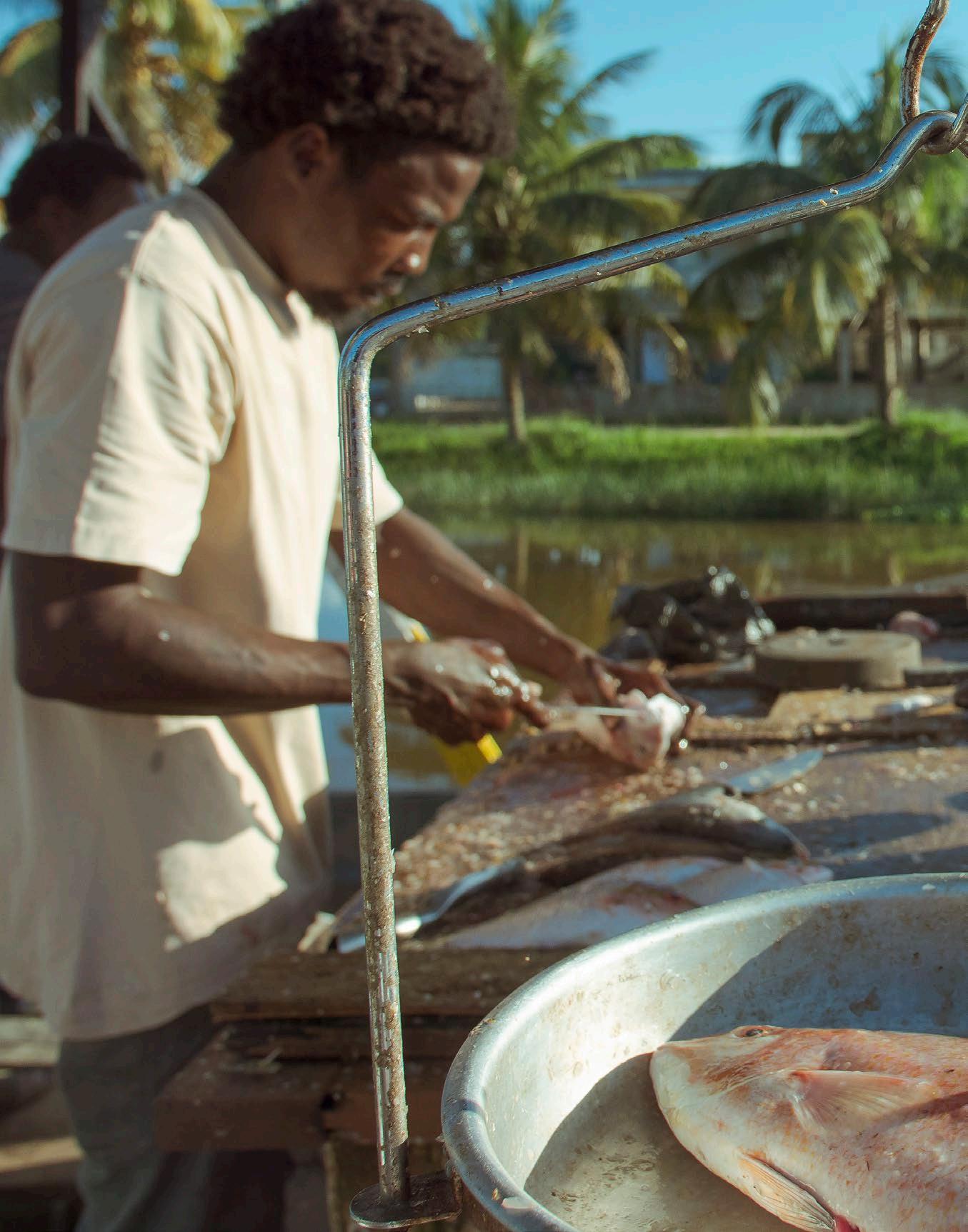
32© Oceana/Alex Ellis
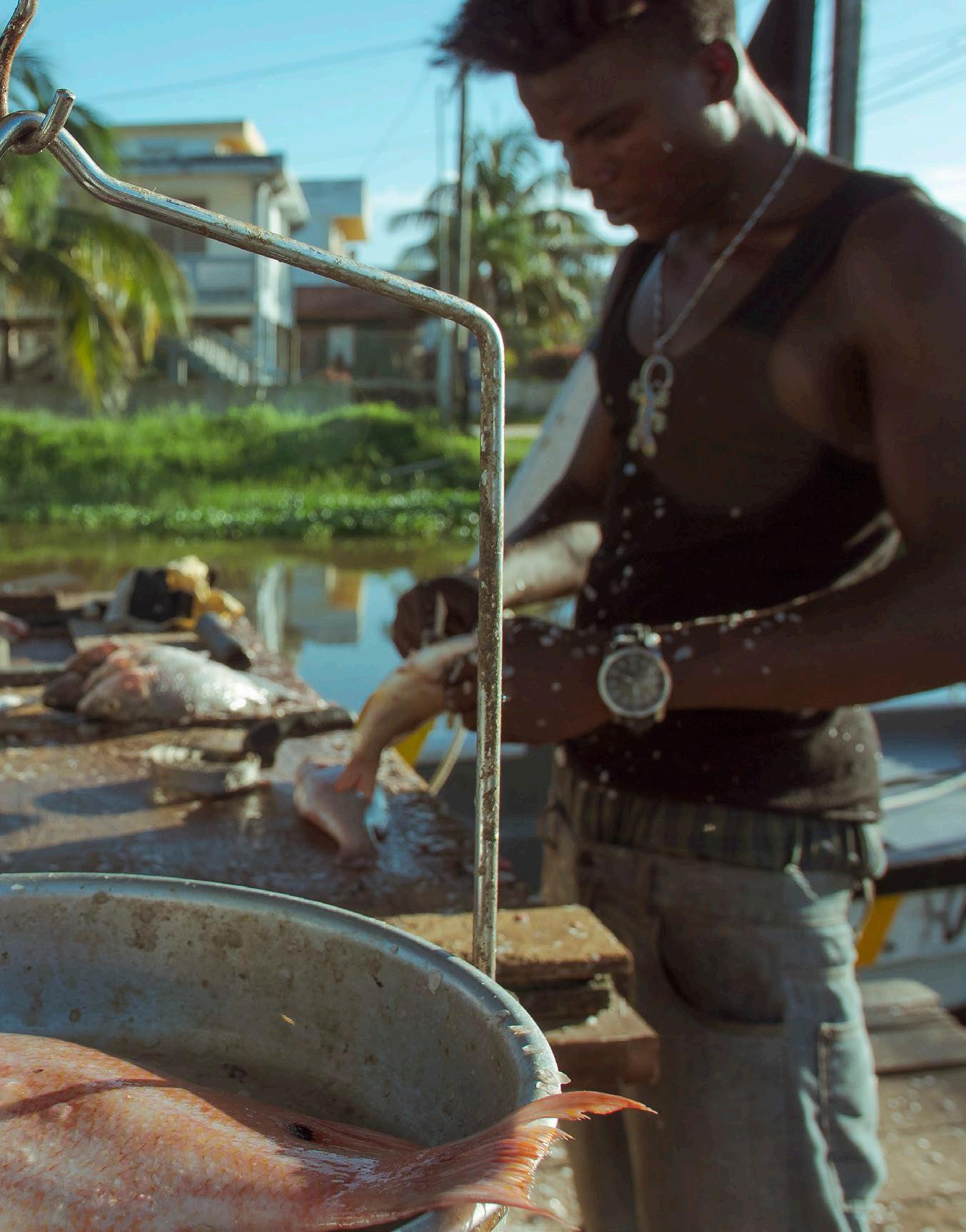
WINTER 2020 | Oceana.org33
A pair of dazzling Bangai cardinalfishes, a popular aquarium fish, are pictured in Indonesia’s Bunaken National Marine Park.
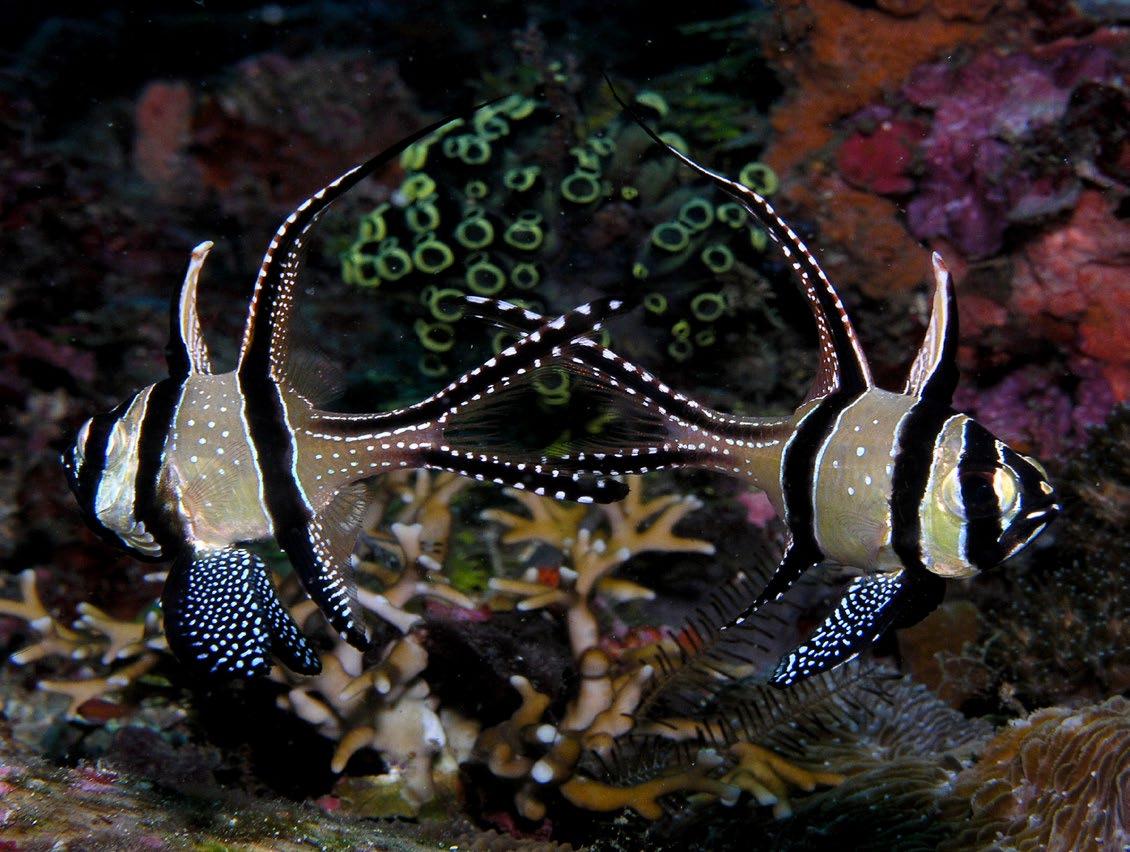
Oceana’s accomplishments wouldn’t be possible without the support of its members.
is a 501(c)(3) organization as designated by the Internal Revenue Service.
Ave NW, Suite 200
toll-free:
Global headquarters: Washington, D.C. Asia: Manila Europe: Brussels | Copenhagen | Madrid | Geneva | London North America: Belmopan | Ft. Lauderdale | Juneau | Halifax | Mexico City | Monterey | New York | Ottawa | Portland | Toronto South America: Brasilia | Santiago | Lima Go to Oceana.org and give today. 1025 Connecticut
Washington, DC 20036 USA phone: +1.202.833.3900
1.877.7.OCEANA You can help Oceana fight to restore our oceans with your financial contribution. Call us today at 1.877.7.OCEANA, go to our website www.oceana.org/give and click on “give today” or use the envelope provided in this newsletter. You can also invest in the future of our oceans by remembering Oceana in your will. Please contact us to find out how. All contributions to Oceana are tax deductible. Oceana
© Oceana/Danny Ocampo

























































